#notes on qing dynasty costumes
Video
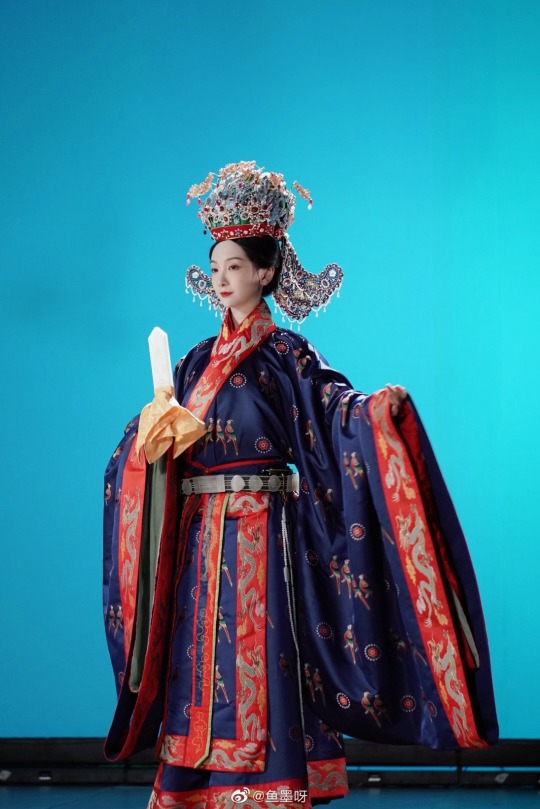
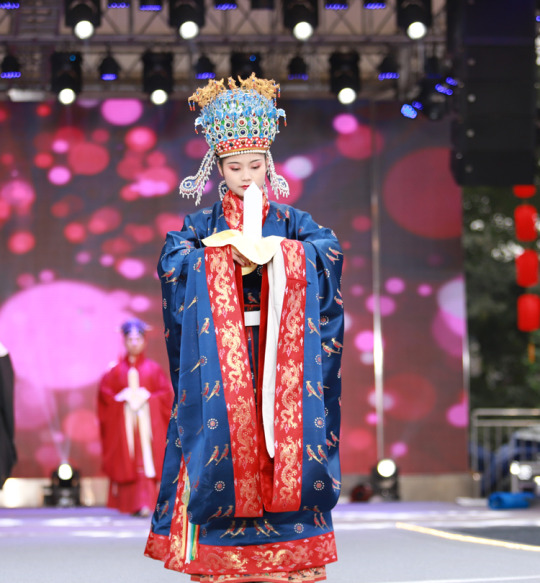


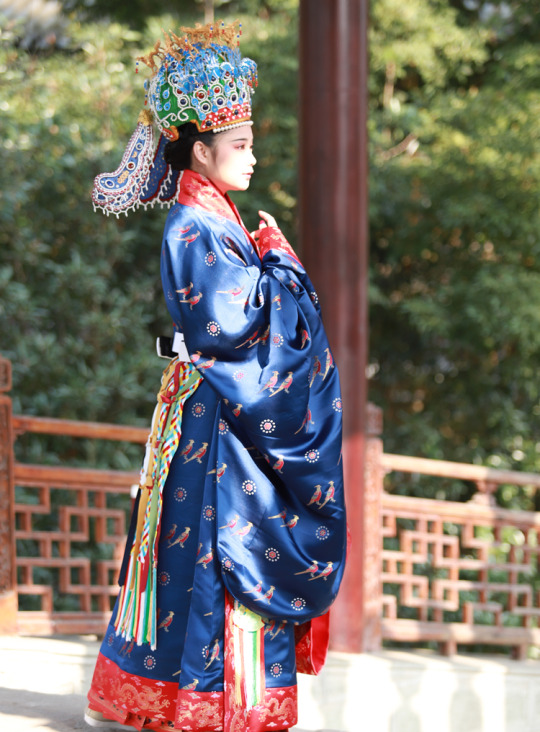
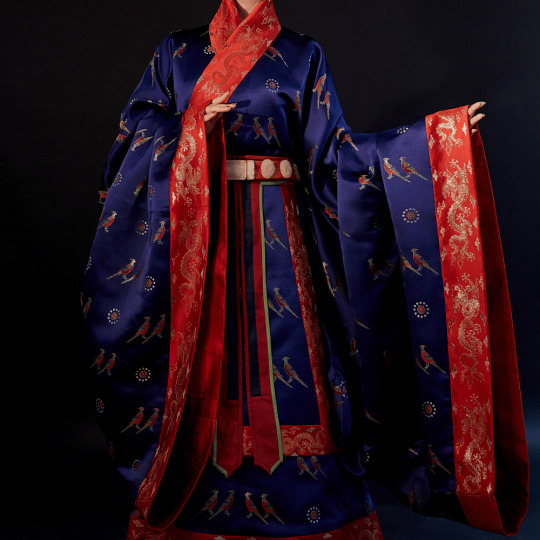

【Historical Artifact Reference】:
Ming Dynasty Royal Portrait:
・Portrait of Empress Xiaoduanxian (Chinese: 孝端顯皇后; 7 November 1564 – 7 May 1620) In ceremonial dress (翟衣/di yi)
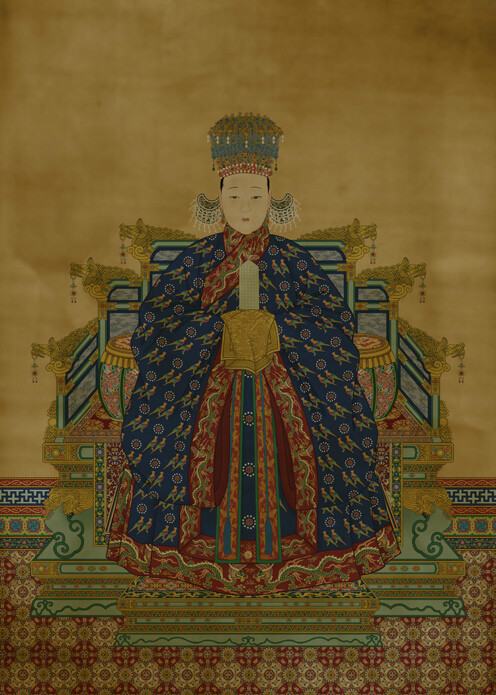
・Nine Dragons and Nine Phoenix Crowns of Empress Xiaoduanxian (※This Phoenix Crowns only for important ceremonial occasion which call “礼冠/Li Guan” wear with ceremonial dress(翟衣/di yi)
----
Unearthed from Ming Dynasty royal mausoleum Ming Dingling (明定陵) , is a mausoleum wehre Wanli Emperor, together with his two empresses Wang Xijie and Dowager Xiaojing, was buried.
In addition to this phoenix crown, the Empress has another phoenix crown for other occasions.
----
Collection of the National Museum of China.
This phoenix crown is 35.5 cm high, 20 cm in diameter, and weighs more than 2,000 grams. It is inlaid with hundreds of high-quality gemstones of various colors and decorated with more than 5,000 fine pearls.




[Hanfu・漢服]Chinese Ming Dynasty Traditional Clothing Hanfu (翟衣) & Phoenix Crown (鳳冠) Reference to Ming Dynasty Relics & Empress Portrait
—–
【History Note】
Diyi (Chinese: 翟衣), also called known as huiyi (褘衣) and miaofu (Chinese: 庙服), is the historical Chinese attire worn by the empresses of the Song dynasty and by the empresses and crown princesses (wife of crown prince) in the Ming Dynasty.
The Diyi also had different names based on its colour, such as yudi, quedi, and weidi. It is a formal wear meant only for ceremonial purposes. It is a form of shenyi (Chinese: 深衣), and is embroidered with long-tail pheasants (Chinese: 翟; pinyin: dí or Chinese: 褘; pinyin: hui) and circular flowers (Chinese: 小輪花; pinyin: xiǎolúnhuā). It is worn with guan known as fengguan (lit. 'phoenix crown') which is typically characterized by the absence of dangling string of pearls by the sides. It was first recorded as Huiyi in the Zhou dynasty(1050–221 BCE).
The Diyi follows the traditional Confucian standard system for dressing, which is embodied in its form through the shenyi(深衣) system. The garment known as shenyi(深衣) is itself the most orthodox style of clothing in traditional Chinese Confucianism; its usage of the concept of five colours, and the use of di-pheasant bird pattern.
【 Influence to Other Country】
Korea
Korean queens started to wear the Diyi (Korean: 적의; Hanja: 翟衣) in 1370 AD under the final years of Gongmin of Goryeo,when Goryeo adopted the official ceremonial attire of the Ming dynasty. Same as the early Korea Joseon, were bestowed by the Ming Dynasty.
According to the Annals of Joseon, from 1403 to the first half of the 17th century the Ming Dynasty sent a letter, which confers the korea queen with a title along with the following items: 翟冠(Ming womens whose husband held the highest government official posts can wear this kind of crown,different from Ming Empress Phoenix Crown 鳳冠), a vest called 褙子(Beizi), and a 霞帔(Xiapei). However, the Diyi sent by the Ming dynasty did not correspond to those worn by the Ming empresses as Joseon was considered to be ranked two ranks lower than Ming.
Instead the Diyi which was bestowed corresponded to the Ming women's whose husband held the highest government official posts. In the early Ming Dynasty period, the Diyi were given to Korea Joseon By Ming, but after the Ming Dynasty reformed the clothing system, The Ming Dynasty bestow the 大衫( Dà shān) to the Korean queen instead of Diyi. The Diyi worn by the Korean queen and crown princess was originally made of red silk; it then became blue in 1897 when the Joseon king and queen were elevated to the status of emperor and empress.
it then became blue in 1897 when the Joseon king and queen were elevated to the status of emperor and empress.
After the fall of the Ming Dynasty, the system of China granting clothing to Korea was interrupted. Korea Joseon were forced to become tributary state of the Qing Dynasty. Korea Joseon carried out "nationalization" based on the costumes bestowed by the Ming Dynasty in the past. But according <Veritable Records of the Joseon Dynasty Volume 46> "嬪宮冊禮時, 旣有翟衣, 則當有翟冠, 而我國匠人不解翟冠之制。 考諸《謄錄》, 則宣廟朝壬寅年嘉禮時, 都監啓以: ‘七翟冠之制, 非但匠人未有解知者, 各樣等物, 必須貿取於中朝, 而終難自本國製造, 何以爲之?’ 云則宣庙有: ‘冠則制造爲難。’ 之敎。 “
Although Korea Joseon has Diyi,but no craftsman know how to make 翟冠(Di Guan), and the materials needed for make 翟冠(Di Guan) need to be taken from China (which need money for that). After all, it is difficult to manufacture in Korea. Therefore, Korea Joseon has not worn 翟冠(Di Guan) since the fall of the Ming Dynasty and change it to 대수머리(大首머리)
Korea "nationalization" process↓
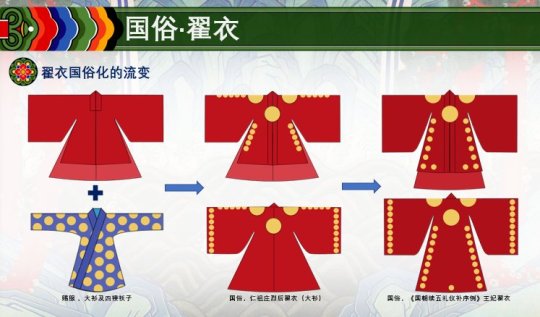
대수머리(大首머리)

Japan
In Japan, the features of the Tang dynasty-style huiyi was found as a textile within the formal attire of the Heian Japanese empresses.
————————
📝Recreation Work & Hanfu: @执月传统服饰 & @鱼墨呀
📸Photo: @执月传统服饰 & @鱼墨呀
🛍️Tabao:https://item.taobao.com/item.htm?spm=a230r.1.14.16.1edc69a6bumOJ8&id=636369495576&ns=1&abbucket=16#detail
🔗Weibo:https://weibo.com/7454398796/K4mehzhsg
————————
#Chinese Hanfu#Ming Dynasty#chinese fashion history#Chinese Culture#Phoenix Crown 鳳冠#Di yi/翟衣#chinese#chinese historical fashion#Empress Xiaoduanxian#Nine Dragons and Nine Phoenix Crowns#Sinosphere#hanfu history#China History
343 notes
·
View notes
Note
Hi! I have a question about... sleeves.
I am looking at designing what is essentially, in-universe, a stage costume but still want it to be at least a tiny bit historically accurate.
It would be a late Jiaqing era (~1810s) inspired aoqun, with a mamianqun (specifically a fengweiqun) and possssssibly a cloud collar to form an ensemble that's intended to portray a fenghuang (thus the skirt lol) and probably somewhat fancy on account of the celestial nature.
I know that sleeves in China have historically often been either long or Extremely Long especially for noblewomen but I was wondering about how that extends (ha) to the Jiaqing era of the Qing Dynasty.
I see, for example, Ming-style clothing that has these very long, drapey sleeves such as these: https://ziseviolet.tumblr.com/post/702949049252364289/ (though I know the Ming would have ended like 200 years before the 1810s but I also know you've mentioned that a lot of Ming fashion continued into the Qing for a while) I like the way they look on account of being very flowy which seems fitting for a bird-themed outfit where the person wearing it would be essentially portraying the fenghuang onstage, so long flowing gauzy shapes seem very fitting, but I'm not sure how much flexibility there is for late Qing sleeve styles or how much creative license goes into those types of XYZ dynasty-inspired outfits.
Relatedly I'm curious how common sheer, soft-draped fabric like that would have been in the early 1800s. I know it was very popular in certain eras, and of course in western fashion at the time Regency clothing used a lot of soft loose shapes, so I'd be interested to know if that kind of thing was particularly common in the 1810s in China or not.
I think sleeves started getting much shorter and more tight fitting in the 18th century, but wide sleeves saw something of a revival by the turn of the 19th. In the Jiaqing era, sleeves could be described as wide but not necessarily long, and usually had folded cuffs that reduced the length. I haven't read about actual garments from that period so I can't tell you concretely, but that appears to be the case from artworks.
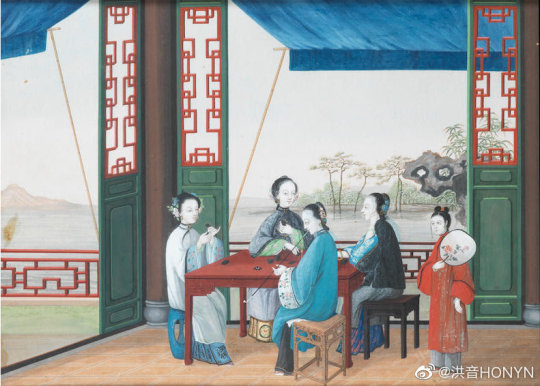
The blogger 盥薇 did a recreation of Jiaqing era dress based on export paintings, in her interpretation the sleeves are also still a little too long to be entirely practical but definitely not as long and drape-y as that in earlier centuries. This outfit might work as a reference for your costume, since it also features a cloud collar? (on a side note, the comment section of this video gives me psychic damage, please don't look)
About sheer, soft fabrics, yes they were indeed very popular around this time, and had been since the late Ming. Sheer clothes were usually meant for lounging around the house in warm weather and not worn outside, and sometimes you see women represented as forgoing underwear altogether. I'm not sure whether that's an artistic embellishment, but it does feel feasible given the domestic setting.
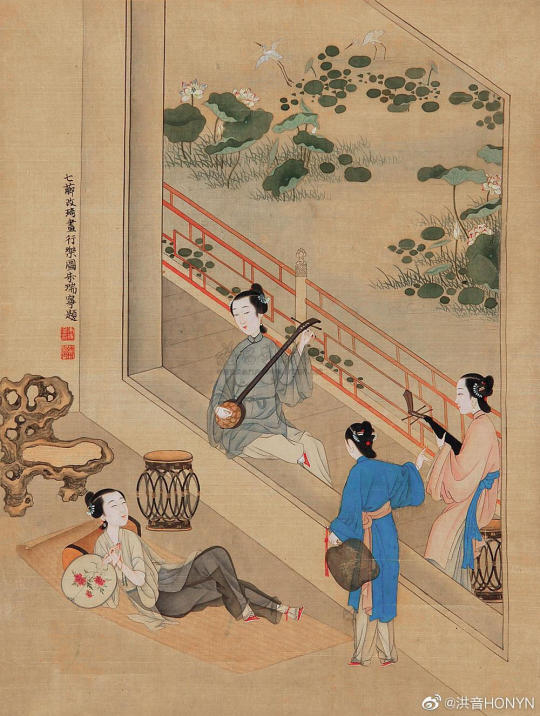

I explained in this post that the cliche of 'late Ming fashion continuing into the Qing' only actually applies to the 1650s. So the Jiaqing era, being in the early 19th century, has nothing to do with the Ming.
62 notes
·
View notes
Text
For #Feathersday: Some selections from the Kingfisher Headdresses from China exhibition at Art Institute of Chicago showcasing tian-tsui, the traditional Chinese fine art of using the highly prized iridescent blue feathers of regional Kingfisher species (Alcedinidae).
Lots more pieces (including smaller hairpins & earrings) on display at the exhibition, open through May 2023.
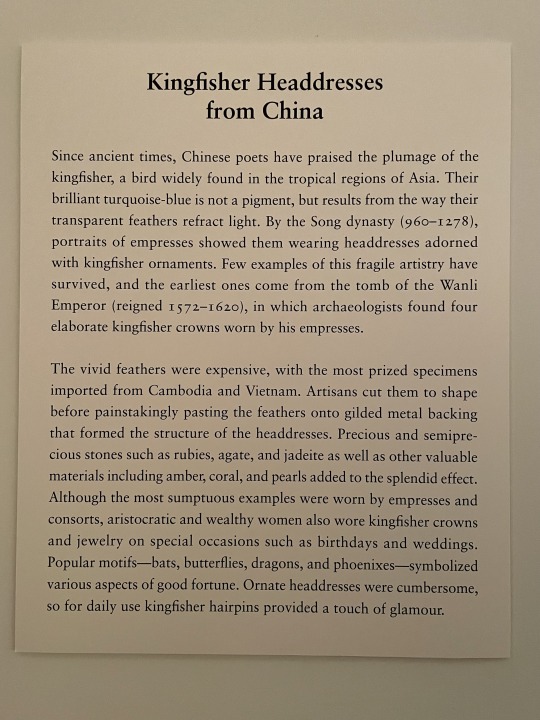
It is also important to note that the demand for feathers for tian-tsui nearly drove kingfishers to extinction in China in the early 20th centry, with the last feather factory closing in 1933. But there are now some contemporary artists reviving the craft who make a point of using ethically sourced feathers (collected from molt etc).

1 Cap (清朝 点翠头饰)
China, Qing dynasty (1644-1912), 18th-19th century
Gold wire, kingfisher feathers, amber, coral, jadeite, ivory, glass, silk
Exceptional workmanship and the brilliant color of the kingfisher feathers make this an outstanding example of a woman's headdress. At the center, a phoenix with a peacock-like tail is flanked by a pair of dragons. Stacked above the phoenix are a large bat studded with a jadeite gem and another executed in fine filigree. Gourds, symbolizing the wish for multiple offspring, appear on the sides and suggest that this cap may have been worn by a young woman.
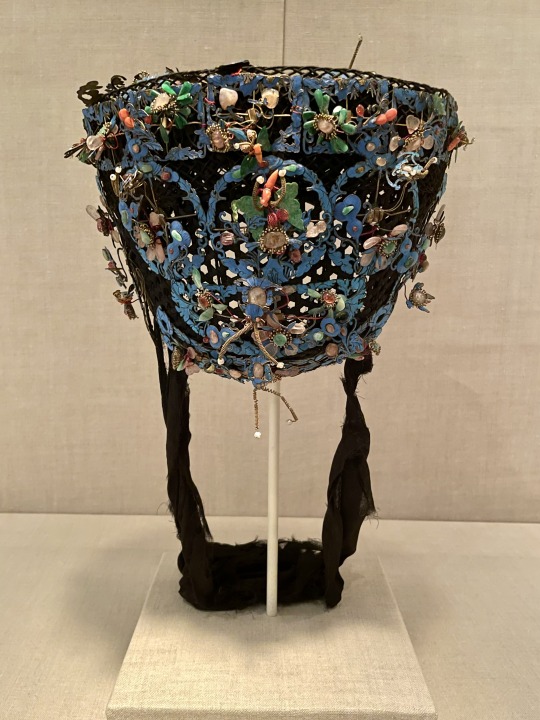
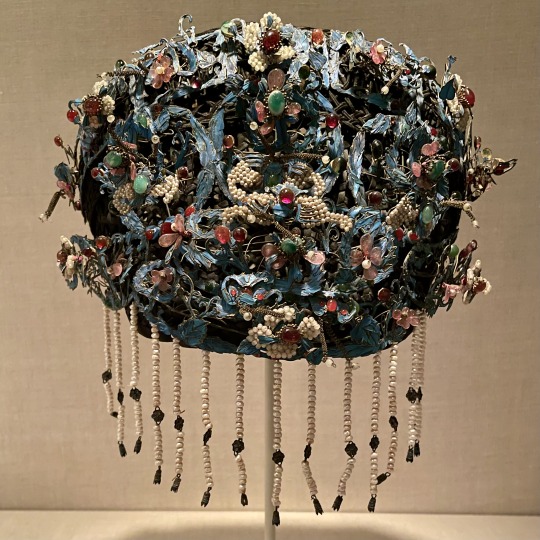
2 Headdress (清朝 点翠头饰)
China, Qing dynasty (1644-1912), 19th century
Silk-covered lattice, kingfisher feathers, gilt bronze, jadeite, coral, amethyst, rose quartz, and carnelian
The central roundel on this headdress features a butterfly with jadeite wings and a coral body while those on either side contain rose-quartz flowers and narrow-waisted bottle gourds, symbols of fertility. Below the butterfly, two bat-like creatures with long antennae and quartz bodies are flanked by gourds. Jade-petal flowers and other plant motifs fill the top register.
3 Headdress (清朝 点翠头饰)
China, Qing dynasty (1644-1912), 19th century
Kingfisher feathers, gilt bronze, pearls, garnets. rose quartz, jadeite, and glass, applied to a silk-wrapped wickerwork trellis
The numerous stylized creatures that adorn this headdress are bats. They represent a motif favored in Chinese art because the Chinese word for "bat" (fu) sounds similar to that for good fortune. The wings of the large bats are fashioned with seed pearls, and red agate cameos indicate the eyes and bodies of the smaller ones. Their long antennae end in pearls, which would quiver with the slightest movement when the headdress was worn. The strings of pearls hanging from the lower rim form a veil.
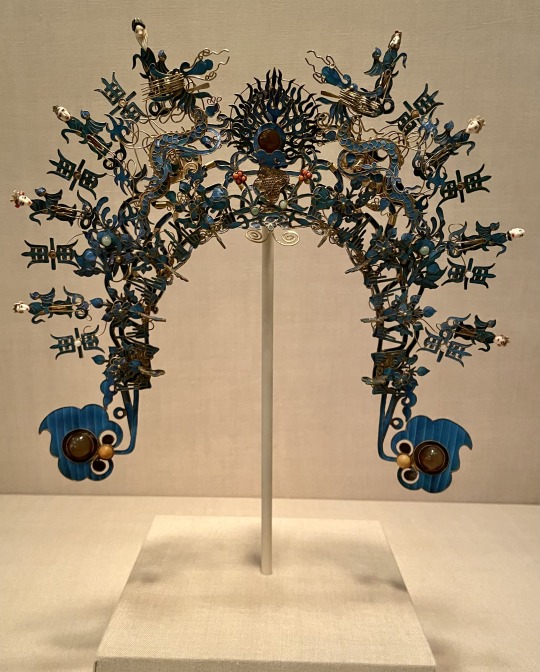

4 Tiara (清朝 点翠头饰)
China, Qing dynasty (1644-1912), 19th century
Kingfisher feathers on silver gilt, jadeite, carnelian, coral, and ivory
In Chinese culture dragons are powerful but benevolent creatures, and the ones that decorate the top of this tiara chase a central flaming pearl- a combination that probably expresses the hopes for a happy marriage. Around the perimeter, stylized characters for longevity (show) and small figures of immortals symbolize a further wish for long life. On the inner rim, the eight phoenixes facing downward are also talismans for good fortune.
5 Tiara (清朝 点翠头饰)
China, Qing dynasty (1644-1912), 19th century
Kingfisher feathers on gold and gilt bronze, agate, and lapis lazuli
At the top of this tiara, a pair of dragons chase a flaming pearl, a motif expressing hopes for a happy marriage. Below them a pavilion probably represents a paradise of immortals, and still farther down are two goldfish, symbolizing offspring and good fortune. The bottom is composed of a row of birds facing downwards, each holding in its beak a string of pearls suspending L-shaped musical chimes. The Chinese word for chime, qing, is similar to that for celebration.
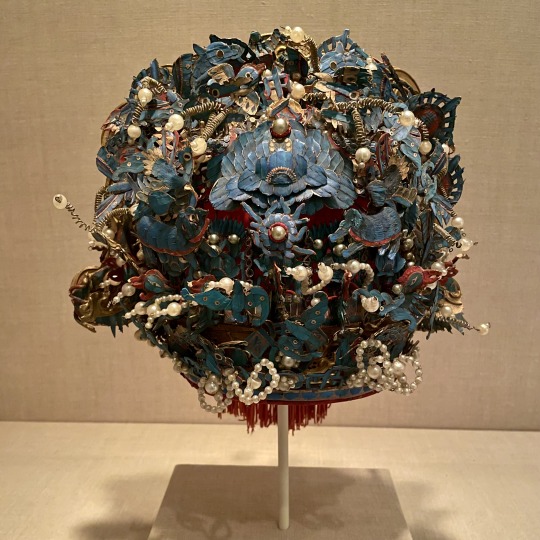
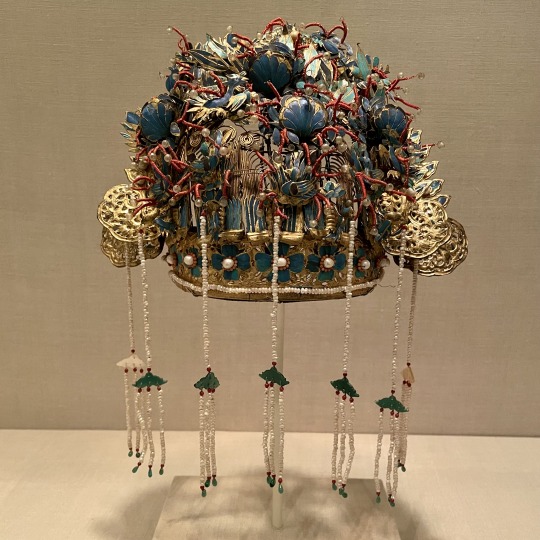
6 Opera Costume Headdress (民国 点翠头饰)
China, first half of 20th century
Kingfisher feathers, gilt bronze, faux pearls, and glass
This headdress teems with symbols of good fortune. The design centers on a large tree peony and below it, a pair of guardian lions flank a flaming pearl. The next row down features red-headed phoenixes and a dragon. A pair of leaping fish--symbolizing a successful career and abundant offspring- appear above the peony. At the top is a pavilion, perhaps representing a paradise of immortals.
More details appear amidst the primary designs: bats and butterflies fluttering their wings and Chinese characters with meanings such as "wealth," "longevity," "nobility," and "glory," collectively imbuing the headdress with an air of celebration.
7 Opera Costume Headdress (民国 点翠头饰)
China, Possibly Guangxi province, early 20th century
Gilt bronze, kingfisher feathers, pearls, coral, silk thread, and glass
Together with phoenixes, mandarin ducks, and bats, four large clamshells decorate this headdress. Each clamshell contains a pearl that is visible only from the side or the top. Contemporary audiences would likely have noticed many pearls dotting the headdress, though, and associated them with the clamshells' contents. In addition to wealth, the pearls probably symbolize a wish for a happy marriage and many offspring.
[all descriptions above from the gallery labels]
***
The only book I know about (in English) about tian-tsui feather art is this one:
Kingfisher Blue: Treasures of an Ancient Chinese Art by Beverley Jackson (2001)

PS - kingfisher feathers aren't really blue - and in fact no bird feathers are known to have "true blue" pigmentation! It's all structural color, just a trick of the light fooling our eyes. :) (Try taking a single "blue" feather and backlighting it sometime to see for yourself!)
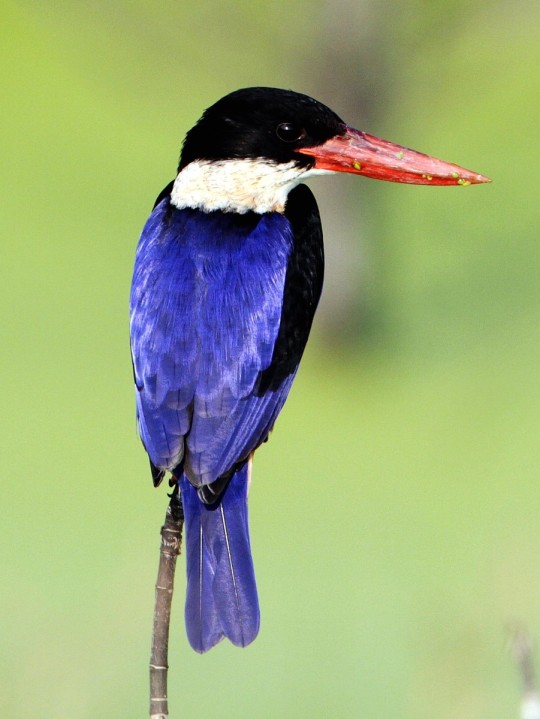
Learn more here:
#kingfisher#bird#birds#birds in art#feathers#feather art#tian-tsui#China#Chinese art#Asian art#Qing dynasty#19th century#20th century#decorative arts#historical costume#headdress#tiara#opera costume#ornithology#color science#blue#exhibition#museum visit#Feathersday#animals in art#book recommendation#Amazon
139 notes
·
View notes
Text

I posted 5,832 times in 2022
That's 1,413 more posts than 2021!
30 posts created (1%)
5,802 posts reblogged (99%)
Blogs I reblogged the most:
@fouryearsofshades
@rongzhi
@hanfugallery
@fuckyeahchinesefashion
I tagged 5,828 of my posts in 2022
#r - 5,765 posts
#hanfu - 3,786 posts
#art - 1,187 posts
#tang dynasty - 810 posts
#audio - 791 posts
#ming dynasty - 738 posts
#video - 734 posts
#mens hanfu - 576 posts
#drama - 572 posts
#art by op - 558 posts
Longest Tag: 96 characters
#i'll always associate this song with the giant dancing ginseng from that one chunwan performance
My Top Posts in 2022:
#5
In wuxia I see that they have half their hair up and the other half down. Is there a certain period where this hairstyle directs from?
Hi, thanks for the question, and sorry for taking ages to reply!
The half-up, half-down hairstyle that you often see on both male & female characters in Chinese guzhuang (period costume) dramas is not based on historical hairstyles. Rather, it is a fairly recent styling convention, most likely originating from late 20th century wuxia TV shows from Hong Kong (x). Over time the hairstyle has become normalized and commonplace in Chinese costume dramas, especially in the wuxia and xianxia genres (because these genres are not necessarily aiming for historical accuracy in the first place).
Below, from left to right: Wang Hedi in Love Between Fairy and Devil, Deng Wei in Miss the Dragon, Xiao Zhan in The Untamed, Gong Jun in Word of Honor:
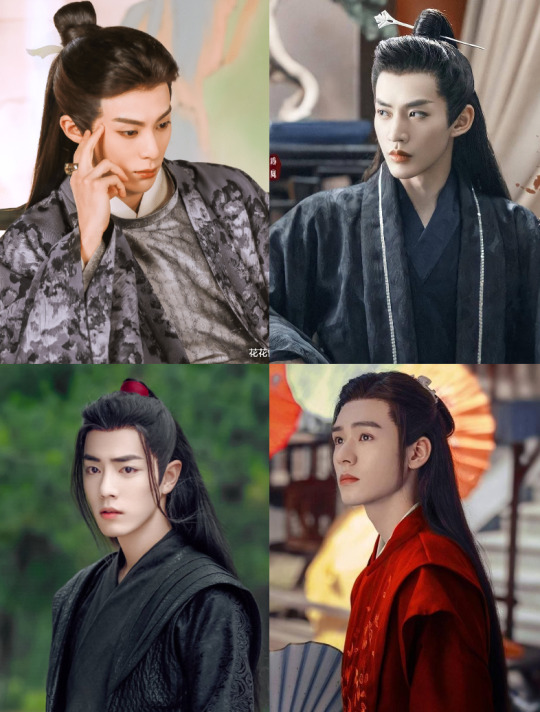
As @niteshade925 explains in this post, for male characters, the main idea of the hairstyle is to make the character look attractive, and also in some shows/context, to hint at the character’s personality, as in maybe they do not adhere to traditional customs and are free-spirited/spontaneous. For female characters, it is usually just a regular hairstyle without deeper meaning :P
For more information on this half-up half-down hairstyle, and historical hairstyles in general, please see the following posts:
The historical accuracy of half-up half-down hairstyles
The historical accuracy of ponytails
Historical hairstyles for men
Hope this helps!
528 notes - Posted October 7, 2022
#4
Dior Mamianqun Controversy
I received the following message via chat from a follower, that I would like to share here:
Hi, 小紫, do you know that Dior appropriates the modernized mamianqun designed by some hanfu brands in china? link of discussion about Dior 2022 A/W show on weibo: https://weibo.com/6323095999/LChcJyPTa?refer_flag=1001030103_&type=repost#_rnd1657858224778 , I think Dior indeed directly referenced the structure of how it's pleated and inner cutouts of mamianqun which has a long history dated back to ming dynasty and influenced the shape of qing dynasty skirts as well, it is sussy, look how the DIOR model turned around when the skirt spread to reveal the split style, this is indeed the unique inner structure of mamianqun, a more rigorous examination requires DIOR to show the flat design, but Dior is not responding, it claims on the official website that this is their exclusive style launched this year, yet the same style of mamianqun has been prevalent among young people in China for several years, there are several taobao stores making exactly this kind of modernized mamianqun since 2018 or even early (metal leather buckle belt + fabric suitable for autumn and winter + long skirts), such as 四时景, 你好美荔, etc., I don't know how to make it an anonymous ask for you to post my question but I would like to listen to your and other followers' comments on this, thank you 小紫(also feel totally free not to post this one, it's your blog and you make the call ❤️
See the full post
1,167 notes - Posted July 15, 2022
#3

See the full post
1,262 notes - Posted January 9, 2022
#2
Hi! I'm really fond of researching about hanfu and its history, and I found a lot of interesting information on this blog. But I can't help it and keep wondering about the reason for qipao/cheongsang not be considered a hanfu? When I researched about it the most common argument is the Manchu influence on it. However, there are a plenty of hanfu styles that were influenced by other cultures. Is there a more especific reason for not consider the qipao?
Hi, thanks for the question, and glad you like my blog! (x)
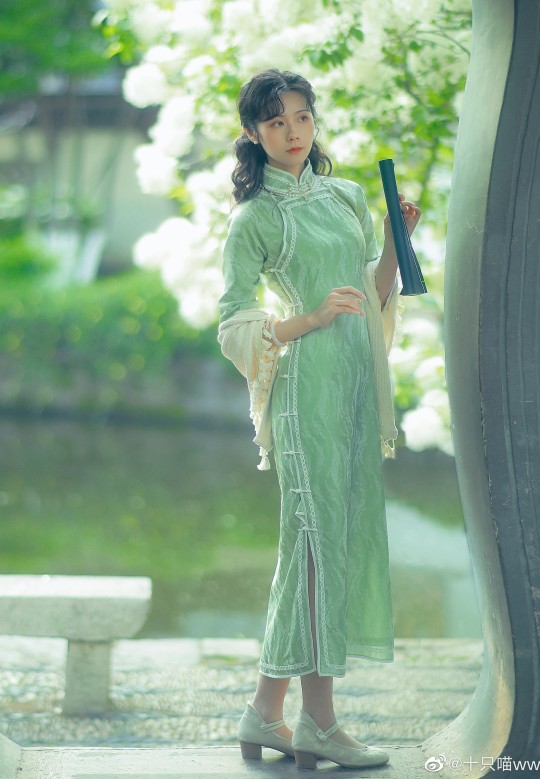
I want to start off with an important disclaimer:
The term “hanfu” as we use it today (defined as “traditional Han Chinese clothing”) does not have the exact same meaning as when it was used historically. As @audreydoeskaren explains in this post, “while it is true that the term “hanfu” was used in some historical texts, they were often used in opposition to clothing worn by foreign peoples...and not as a standalone term”. Today, there is no central organizing body or law that states exactly what is & what is not considered hanfu. Rather, such categorization is done by the members of the hanfu community - and the hanfu community is not a monolith. Ever since its inception in 2003, the hanfu revival movement has been a grassroots, bottom-up movement with members of various backgrounds, ideologies, and opinions. It is a movement that is built upon, and driven forward by, constant dialogue and debate among its members. Thus the question of what garments are considered hanfu is under continuous discussion, and is subject to the hanfu community’s views and ideas on culture, clothing, and history.
See the full post
2,167 notes - Posted March 6, 2022
My #1 post of 2022
What exactly does Dunhuang style mean?
Hi, thanks for the question! (x)

Dunhuang/敦煌 style refers to the art, fashion, and culture depicted in the Dunhuang Murals/敦煌壁画 of China, which are located in the Mogao Caves in Dunhuang, Gansu Province. From the 4th to 14th century, the caves were constructed by Buddhist monks to serve as shrines with funds from donors. These caves were elaborately painted, the cave paintings and architecture serving as aids to meditation, visual representations of the quest for enlightenment, and teaching tools for Buddhist beliefs and stories. The major caves were sponsored by patrons such as important clergy, local ruling elite, foreign dignitaries, as well as Chinese emperors (x). Below - painting from the Dunhuang Murals (x):
See the full post
3,306 notes - Posted January 1, 2022
Get your Tumblr 2022 Year in Review →
#tumblr2022#year in review#ziseviolet#personal#2022#hanfu#qipao#my 2022 tumblr year in review#your tumblr year in review#chinese fashion#chinese culture#china#s
37 notes
·
View notes
Text
halloween best selling props
In recent years, extreme insulting remarks have frequently appeared in the media. The recent American Broadcasting Corporation (ABC) program "The Jimmy Feather Show" "Kill all the Chinese" caused an uproar among Chinese people all over the world. Strong dissatisfaction and protests have forced ABC to apologize and stop the program. According to media reports, American stereotypes about Chinese are still deeply ingrained. In the United States, which advocates multiculturalism, there are still numerous cases of racial discrimination.
Shortly after the ABC insulting China incident, on the eve of Halloween at the end of October, many of the holiday props sold in the United States that contain elements of "insulting China" are still hot sellers. According to local media reports, the Halloween props sold in the United States this year include a "ridiculous Chinese Asian male Lin Yuqun" (Observer Network Note: Lin Yuqun became popular because of his participation in the Taiwan talent show "Avenue of Stars", known as the Taiwan version of Aunt Susan. The props of American talk shows as a funny topic), various Qing Dynasty hats with pigtails and the costumes of sexy "takeaway" Chinese food service women can be seen everywhere on the Internet and in brick-and-mortar stores. These masks and costumes with strong cultural stereotypes seem to have a good market on the Internet, which reflects the deep imprint of the "negative" image of Chinese people in the hearts of the American people.
0 notes
Note
do you know what is the name of the white scarf thing worn by women in qing dynasty dramas? thanks!! i love your blog!!
We have a post about this scarf/collar posted a while ago, but I just realised I never actually said what it’s called 😂.
Actually, to talk about Qing dynasty collar, we should go back to this post on Ming dynasty clothes where I linked this video on Ming dynasty upright collar, which is the ancestor of the mandarin collar that nowadays tends to be associated with the Qing dynasty, when in fact it originated from the Ming dynasty.
Originally traditional Manchurian clothes had round collars and not standing collars.


For this reason they would add detachable collars, of which there were two types:

Left: longhua lingjin 龙华领巾 // Right: yingling 硬领
These collars were said to originate from the Shunzhi era, when Confucianism was starting to affect the rule of Qing emperors. Women exposing their necks were then considered unseemly and immodest, which gave way to the need for a collar to cover the neck.
硬领 yingling
Yingling is what Europeans would eventually call mandarin collar, used by both men and women. It is a pressed collar and worn with clothes of varying formality.
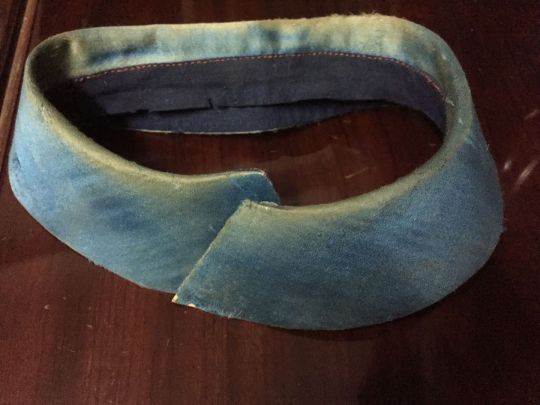
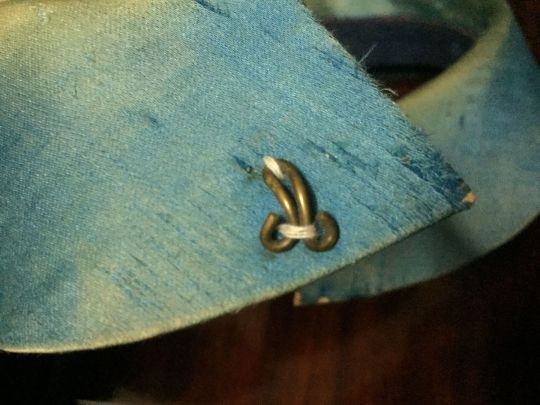

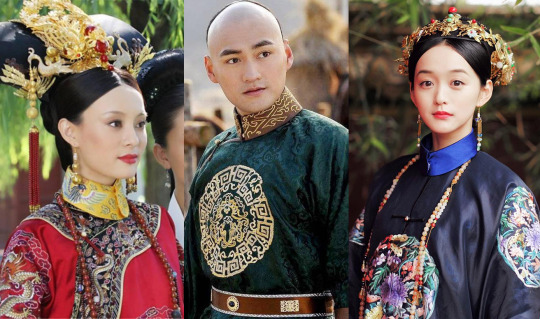
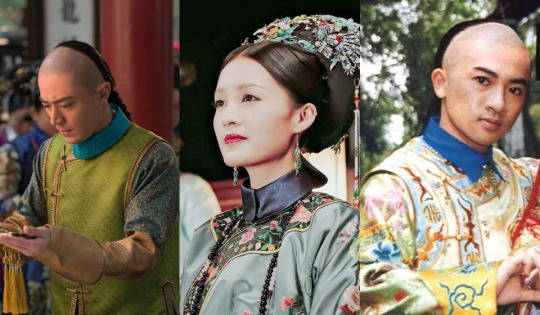
You can in see in Xiangjian’s photo (centre) that the collar lifts off her neck and is a separate piece from the gown.
In winter, yingling would be made of fur for warmth.

龙华领巾 longhua lingjin
Also called just longhua, these are the hanging white scarf worn by women. Longhua first serves the purpose of keeping the neck warm and also covering women’s neck for modesty.
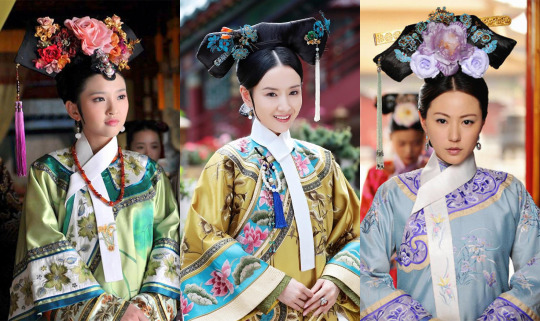
The length of and embroidery on the longhua can sometimes differentiate ranks of different women in the palace. Higher-ranking women will likely have longer longhua. Also the higher the rank, the more elaborate the embroidery. With so many women in the palace, longhua can help tell the relative/approximate rank of different women at a glance.

🤣 they reused Yixiu’s longhua in Zhen Huan on Langhua in Ruyi.
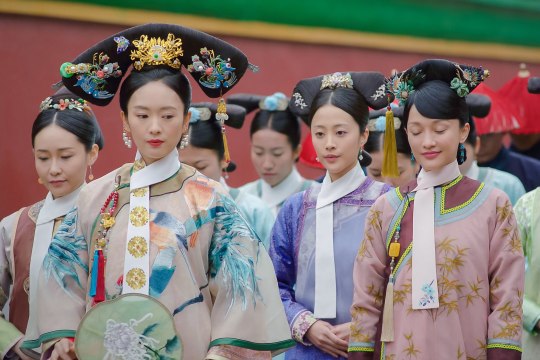
Xiyue’s longhua as noble consort vs. Ruyi’s simpler longhua as consort.
Also, more recycled longhua:
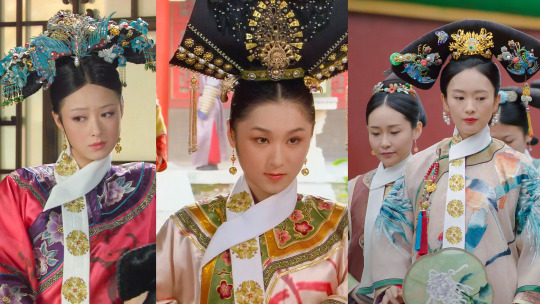
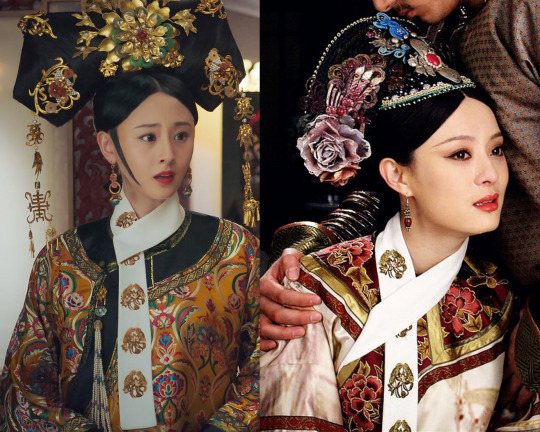
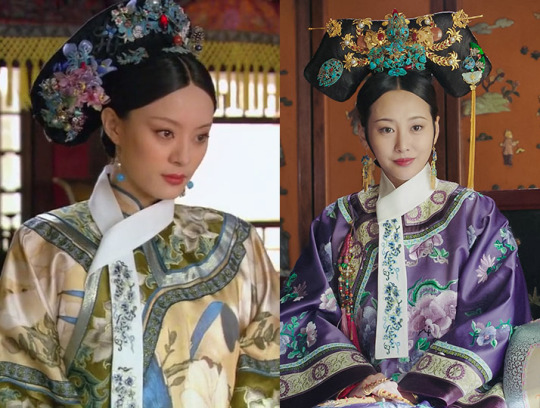
Note below Ruiji’s plain longhua as daying vs. Yuyan’s embroidered longhua - she’s at least guiren here? or maybe even pin.

Younger women would have longhua embroidered with flowers and youthful motifs. Meanwhile dowager empresses and dowager consorts would usually have longhua embroidered with characters like shou (longevity) or fu (fortune).
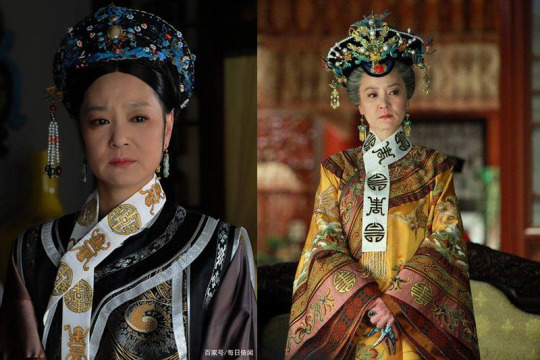
Liu Xue Hua playing two different empress dowagers and wearing practically the same longhua 😂😂😂. To be fair, this is also based on Cixi’s longhua in the photo below.
Longhua is worn around the neck and with one end tucked under the gown panel between the first and second button of the gown, as seen in the paintings and photo of Cixi below. Most dramas tend to have actress wear longhua incorrectly.

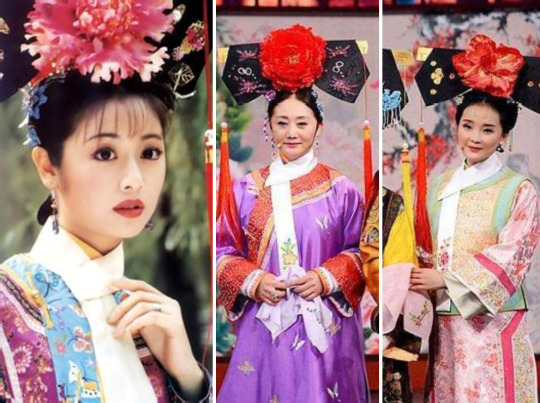
Huan Zhu Ge Ge left to right: Zi Wei is wearing it wrong. The longhua should be tucked into the closing panel of her gown. This is actually how all the women in the original HZGG wore their longhua. And yet in the middle pic, Ling Fei is wearing it correctly. Qing Er is wearing it wrong, even though the longhua is tucked into her gown, it is tucked too low, probably below the second button. The funny thing is, this is a photo of Zhao Lijuan (the actress who played Ling Fei) and Wang Yan (actress who played Qing Er) participating in the same episode of the same variety show (Ace vs Ace). Either they dressed themselves and Wang Yan got it wrong or they had two different people dressing them.

Legend of Ruyi: lol again Ruyi is wearing it correctly while Hailan is wearing it wrong (tucked under itself, not inside the gown). This is because in this drama, Ruyi had her own costume person/team, while another team handled all the other characters’ costumes. This is also why the only person wearing longhua correctly in this drama is Ruyi herself (below):
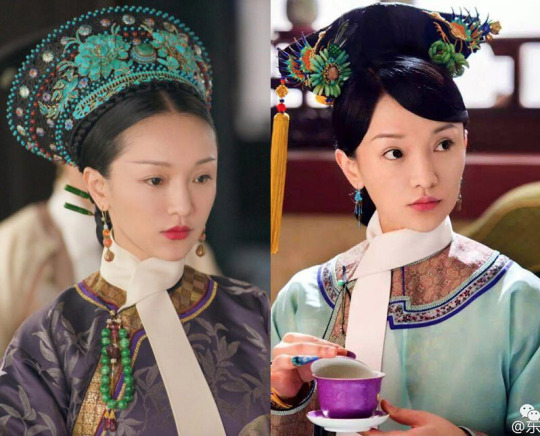
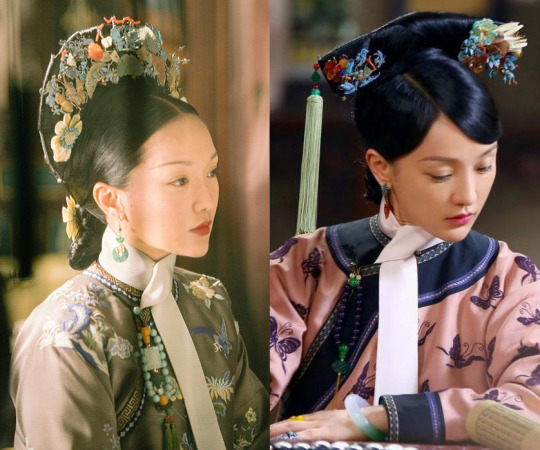
Everyone in the next two photos is wearing it wrong, either not tucked into the gown (everyone in Ruyi and Xiao Yan Zi), or tucked too low and too loose (Ruo Lan in BBJX and Hua Fei in Zhen Huan.)
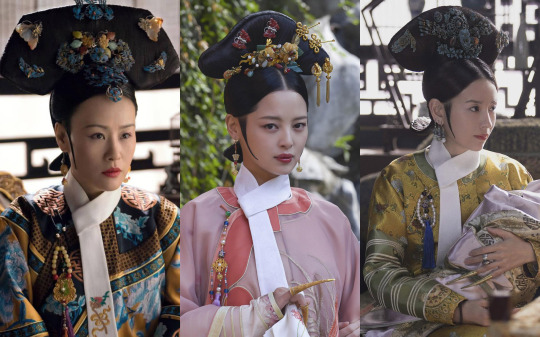

Story of Yanxi Palace doesn’t actually bother with longhua at all and either just have the characters wear the round collar with nothing covering the neck, the standing collar or cloud collar (yunjian) (left to right below).
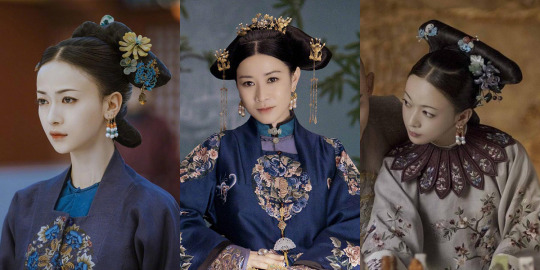
Since there are not many surviving paintings of women in the palace in more informal context (i.e. not formal paintings), it’s difficult to tell when standing collars begin appearing in Qing dynasty dress, so I guess there is possibility that this could be accurate? (The square collar on the outer layer also show influence of Ming dynasty dress.)
In any case, as time went on, standing/upright collar like that in the centre photo start becoming more and more common in the court dress of women in the palace, so longhua can sometimes be omitted, as seen with photos of Empress Wanrong below.
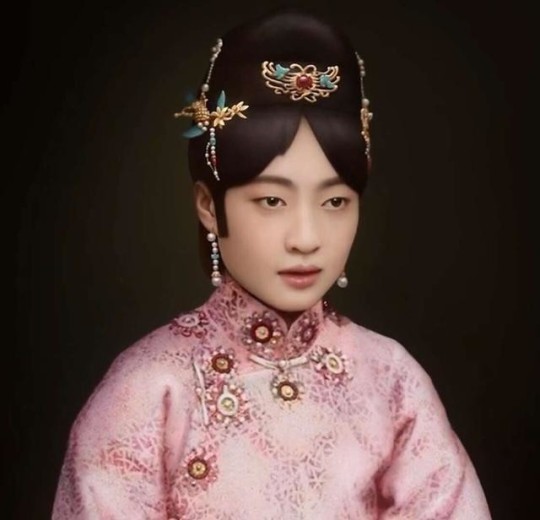
(recoloured photo)
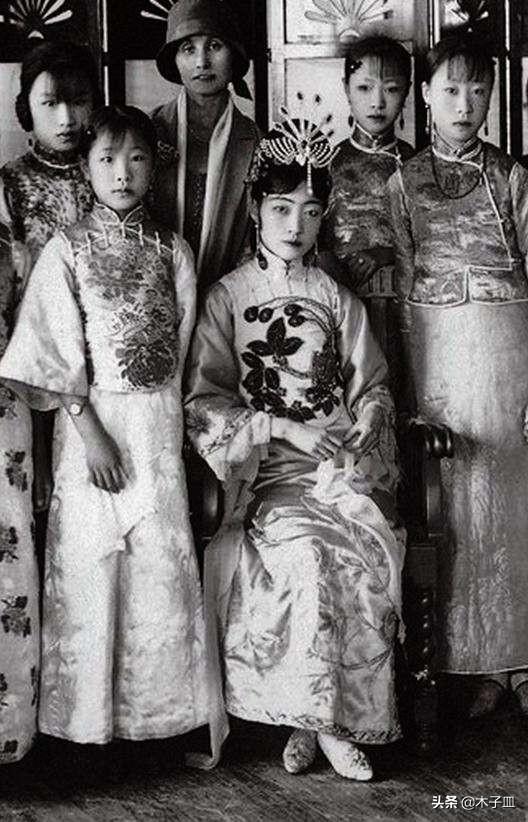
However, photos of court women in the late Qing dynasty show that longhua can still be used, as seen some photos of Cixi.
This combination of yingling and yunjian in Love Story of Court Enemies looks off, though, mostly because the yunjian originated as a hanfu item of clothing from prior to the Qing dynasty, so combining it with the yingling just looks weird ¯\_(ツ)_/¯
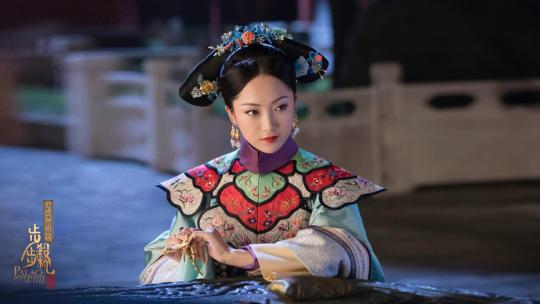
More on Qing dynasty costumes in dramas -h
#cdrama#qing dynasty#legend of ruyi#legend of zhen huan#huan zhu ge ge#startling by each step#the story of yanxi palace#scarlet heart#bu bu jing xin#notes on qing dynasty costumes#reference#clothing hair make up#clothing reference#ask
289 notes
·
View notes
Text
- Ethnic Differences in Court Dress During the Qianlong Period -
Many court palace dramas set in the Qing dynasty Qianlong reign period have detailed and beautiful costumes. One of my favorites being the 朝服 cháofu (court dress) and the 吉服 jífú (ceremonial dress)
guzhuangheaven made wonderful posts talking at length about both types of garments, their parts, uses, terminology, symbolism, etc… If you wish to learn more about them, please check the following two links:
Chaofu
Jifu
However, I recently discovered that in Qianlong’s court, at least as far as jifu is concerned, concubines of different ethnicities wore their respective ethnic fashions.
It all started with a painting from 1771-72 titled 《崇庆皇太后八旬万寿图》 or Longevity Image of Empress Dowager Chongqing’s Eightieth Birthday. Empress Dowager Chongqing is Qianlong’s mother.

《崇庆皇太后八旬万寿图》 or Longevity Image of Empress Dowager Chongqing’s Eightieth Birthday prior to conservation [source].
What fascinated me is not easily seen; a “blink or you’ll miss it” detail. On the Empress’ and Qianlong’s sides, are the rows of standing and sitting concubines who served the Emperor. We have concubines of different ethnicities such as Manchu, Han, Uyghur, and Mongolian. This painting offers us an invaluable opportunity to see the distinct ethnic court dresses worn during the Qianlong reign period.


Mongol Uyghur Han Manchu
We rarely see these these types of ethnic fashions in historical dramas. At most, we get concubines with a vague ethnicity wearing some beaded hair jewelry and a face veil, cue some belly dancing for extra effect.
Since the ethnic concubines are sitting behind the first row of concubines who are ranked 嫔 pín (concubine), 妃 fēi (consort), 贵妃 guìfēi (noble consort), and 皇贵妃 huáng guìfēi (imperial noble consort), they would be lower than concubines in rank. However, it is worth noting that the Uyghur woman is most likely the titular容妃 róng fēi (consort Rong) who would have obtained the rank of consort by the time this picture was painted in the early 1770s yet is not wearing the chaofu that the other consorts have. Other non-manchu concubines, upon attaining the rank of concubine or higher, would have to wear the chaofu that the Manchu ladies have. Two notable examples of this are Imperial Noble Consort Qinggong and Imperial Noble Consort Shujia who have Han and Korean ascendancy respectively.
- Uyghur -
It is not clear why consort Rong is not wearing the chaofu and why she is sitting behind; perhaps, she was demoted at that time or must sit behind because she does not have children (or is not Manchu).
It is entirely possible that the ethnic court dress that the Mongolian, Han, and Uyghur concubines are wearing in the pictures above are equivalent to the jifu.
Below is a another possible picture of consort Rong wearing bright red clothing (according to this study) next to two other Uyghur women (please, notice the two long braids coming down from underneath their hats). Consort Rong could have also been the one on the far right hand side. It is difficult to tell. However, what’s important is the clothing that they wear which is clearly distinct form the four other women’s.

The image above is an enlarged portion of a much bigger painting titled 《塞宴四事圖》 or Watching Four Performances at the Imperial Banquet in Northern China [source]. Qianlong period. Painted by Giuseppe Castiglione.
Another example of ethnic clothing worn alongside distinct headwear comes from the following painting:

The above image is a portion of a much bigger painting titled 《万国来朝图》 or Image of All Nations Coming to Court, painted in the Qianlong era and depicting the arrival of foreign envoys bearing tributes during New Year to the Qing court while wearing their respective ethnic clothing [source]. Anonymous painter.
It is unclear whether the woman wearing the distinct hat is once again consort Rong; it could be another Uyghur concubine but it’s worth noting how the dress style and pattern match in the two images above.
The dresses that the Uyghur women are wearing, including consort Rong in the longevity painting, seem to be a type of 比甲 bǐjiǎ from the Qianlong period (explanation of bijia and other Qing dynasty women’s fashion was provided by @ziseviolet , please click here to learn more).
- Mongolian -
The concubine that fascinated me the most in the painting is the Mongolian one since her court dress looks closely modeled after the chaofu of the first row of concubines. Please, notice the 披领 pīlǐng (Qing dynasty capelet) in the Mongolian court dress.
After doing exhaustive research, I came across a list of the names of some of the other concubines in the painting.
According to Baidu, she may be 新常在 xīn chángzài (first-class female attendant Xin). She was lated elevated to 贵人 guìrén (noble lady). She was Oirat Mongolian and died in 1774, 3 or 4 years the completion of the painting.
Her hat is distinct from her Manchu counterparts’. After doing some research on Oirat ethnic clothing, I came across this picture of a ceremonial Oirat hat.
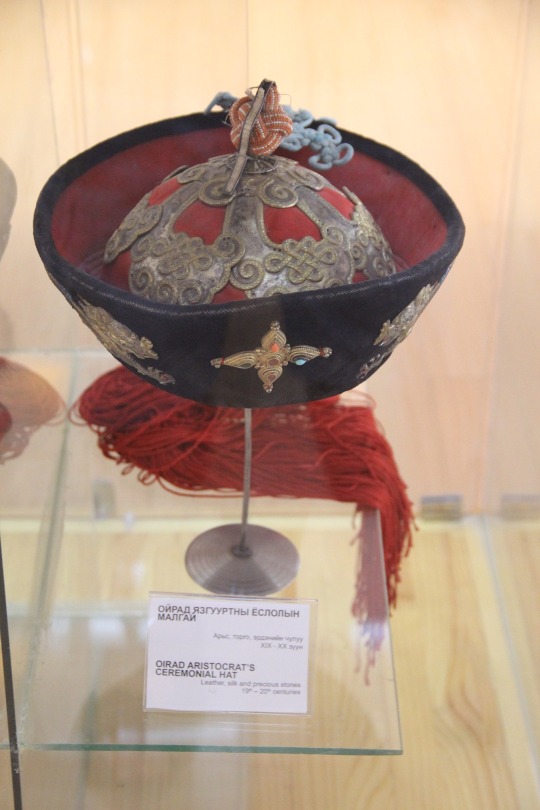
Photo taken by Gary Todd on June 30, 2017 [source]. Mongolian Traditional Clothing and Jewelry Gallery, National Museum of Mongolia, Ulaanbaatar.
Even though it’s not an exact match and is off by one or two centuries, it does show that Oirat people have a tendency to bejewel the black velvet bodies of their hats symbolizing a possible tradition.
If it is indeed true that she was a changzai during the time this painting was made, then this poses a few interesting questions. In the Qing Imperial Harem Ranking System, changzai were one of the lowest ranks. Thus, according to protocol, she should be wearing a jifu instead, but she is not.
At first, I thought that what she was wearing was her ethnic jifu equivalent, but upon close examination, one can clearly see the black fur lined and red piling, an element distinctively found in the Manchu chaofu. The overall aesthetic look of her court dress reminds me more of the Manchu chaofu than a jifu, although, the 团纹 tuán wén (circle pattern) on the sleeves are definitely more consistent with jifu (to see a more thorough explanation given by @guzhuangheaven on circle patterns, please click this link). Her court dress blends elements of both.
The jewelry she wears, especially the big square pendant, is a staple of Mongolian jewelry as well as the scarf attached to the back of her hat.
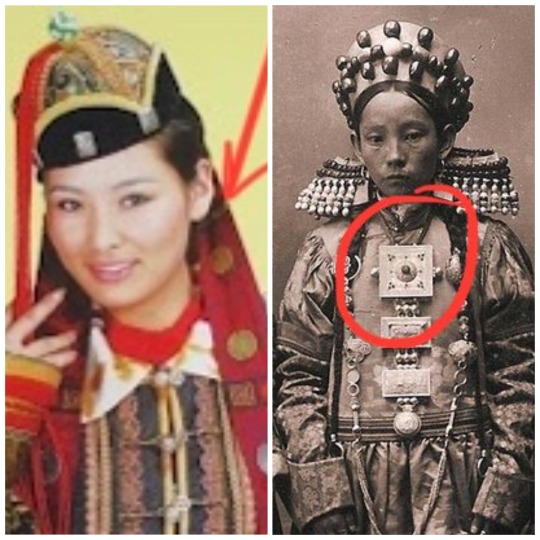
Left picture source [source]. Right picture source [source] If you look at the uncropped left image, you can see the shoulders extend in peaks, similar to regular chaofu piling.
Back to the topic of her rank, if she is, in fact, a changzai, then why is she sitting so close to the Emperor and Empress Dowager? There are other concubines, some with children, standing on the sides (please look at the full painting to analyze at this detail). It could be entirely possible that the children are those of the first row of concubines and that the lower ranked ones are taking care of them.
Furthermore, it’s plausible that those on the sides are all lower than changzai, if that is the case, then Qianlong had many 答应 dā yìng (lower rank than changzai) and/or many women ranking lower than the concubine rank.
The color that the Mongolian concubine has on her court garments is also distinct and begs the question, why is it turquoise? (or green as they probably would have considered that to be back then). That specific color I have seen in Mongolian clothing and jewelry but I am unsure as to the symbolism behind it. If anybody knows what that color or shade represents to Mongolians or Oirat people, please let me know. Perhaps the color was chosen because of her ethnic background or because of some other reason. Without another painting showcasing a similar court dress, records, contemporary descriptions, or surviving garments, then it’s impossible to arrive at any definitive conclusion.
The Turquoise-like color is seen in Mongolian traditional attire, ceremonial silk scarves, and jewelry:
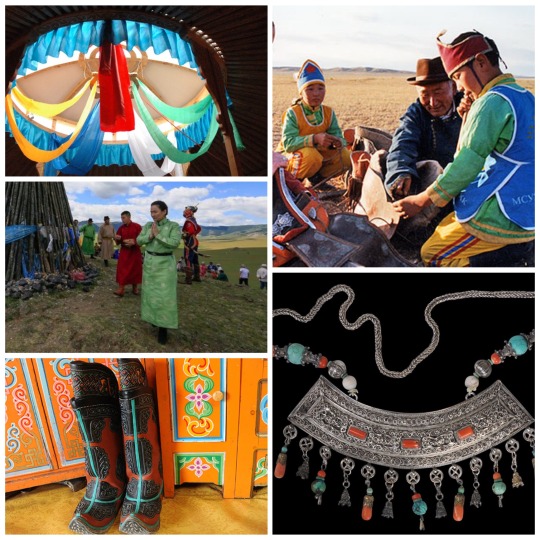
The above images can be found online. Credit goes to their copyright holders.
You can also see that specific color being worn by the Han concubines in the same painting underneath their red outer layer. Not sure if there is a meaning behind the color itself but the chaofu/jifu worn by the Mongolian lady is dyed with it which is distinct from the black, yellow, golden, and deep blue we usually see in Qing dynasty court fashion. I have also seen that shade in other paintings of Han women from the Qing dynasty [source]. It could either be a symbolic color or one of the available shades of green produced naturally by accessible pigments of the time period.
- Han -
As far as the court dresses that the Han women are wearing, there isn’t much that I can add or say that much more knowledgeable professionals haven’t already stated.
The Han women seem to be wearing 鳳冠 fèngguān (phoenix crown) and a Qing dynasty style of dress popular with Han women which consists of a top with a pleaded skirt called 袄裙 ǎoqún (blouse and skirt). Although the following example of the modern replica does not contain the 马面裙 ma miàn qún (horse face skirt) that we see in the painting, the ratio of the length of the upper part compared to the lower part is similar, as well as the wide sleeves and round collar.
The Han women’s court attire also blends elements from the Manchu-introduced chaofu and late ming dynasty court dress. Please notice the 立水 lìshuǐ (loosely translated as vertical water) also known as 水脚 shuǐ jiǎo (water foot) at the bottom. A pattern that started in the late Ming dynasty and eventually grew into the iconic wave pattern we see in Qing dynasty chaofu.
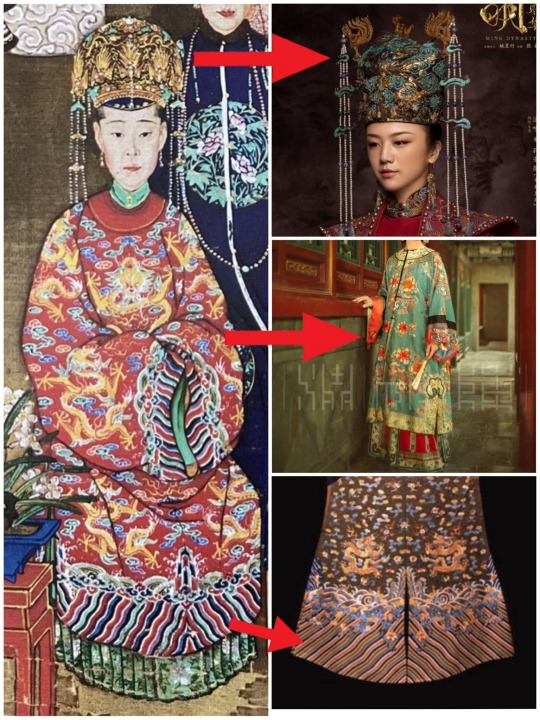
Phoenix crown modern replica is a prop from the Chinese costume drama Ming Dynasty (2019) [source]. Qing dynasty modern aoqun replica courtesy of @潤熙陳 on Weibo [source]. Lishui wave pattern from a man’s dragon robe with peacock feather embroidery. Santa Barbara Museum of Art [source]. The pictures and painting are not an exact match, however, they are close enough to get an idea.
In another painting titled 《乾隆南巡圖 (第六卷﹕大運河至蘇州)》 or The Qianlong Emperor's Southern Inspection Tour (Scroll Six: Entering Suzhou along the Grand Canal), there are figures that look like women kneeling to receive the emperor while wearing clothes resembling Qing dynasty Han fashion. You can faintly make out what seems to be phoenix crowns or some other type of tall head ornament. Of course, this may be a reach as the figures are too small and lack any serious detail to be considered Han or any other ethnicity. However, the belt and contrasting red sleeves with blue dress does make one wonder.

《乾隆南巡圖 (第六卷﹕大運河至蘇州)》 or The Qianlong Emperor's Southern Inspection Tour (Scroll Six: Entering Suzhou along the Grand Canal) painted by Xu Yang et al. in 1770 [source]
-Theories-
Why then, are the concubines in the court of Qianlong dressed differently according to ethnicity (based on the longevity painting)?
I cannot give an exact reason. My cultural, historical, linguistic, and ethnic knowledge cannot hold a candle to that of actual experts. The following are mostly my own conjectures from research I personally did.
Kangxi, Yongzheng, and Qianlong were known to have had Han concubines. Non-bannermen (or bannermen) Manchu rarely married non-bannermen Han. However, a Manchu bannerman and a Han bannerman could get married. Han-ethnic concubines were all from bannermen families, thus, making the union legally possible and without nearly as much stigma. However, that still doesn’t answer the question as to why in Qianlong’s court these stark ethnic divisions existed in clothing. I tried to look for Kangxi and Yongzheng reign period court paintings with stark ethnic division of clothing for the concubines but couldn’t find anything remotely similar to what we see in the painting of Qianlong’s mother’s 80th birthday.
By the time of Qianlong’s reign, he noticed that Manchu women, both inside and outside the imperial court, were starting to adopt Han customs such as foot binding and wearing one earring on each ear (Aierken, 2019, p. 31). This greatly displeased Qianlong since he feared that, with the passing of time, the Manchu language, clothing, traditions, and culture would be replaced by that of the Han. Other ethnic groups that went to live in China progressively adopted Han cultural aspects in the past (Sinicization). This is not surprising since the Han were (and still are) the largest ethnic group in the region and world.
Due to the relatively low rank regular (non bannermen) Han people held in Qing society, Qianlong was probably worried that they would regain power through the adoption of Han customs by Manchu and other ethnic minorities.
As a result, he prohibited Manchu women from binding their feet and made his concubines, Manchu and Han bannermen, (as demonstrated by the portraits of Imperial Noble Consort Qinggong and Imperial Noble Consort Shujia) practice 一耳三钳 yī ěr sān qián (one ear, three pliers/earrings). The aim was to preserve Manchu tradition and to stop the encroachment of Han customs on the ruling class and people alike.
However, it is also important to note that, although Qianlong wanted to preserve Manchu tradition and culture above all others,
“The emperor had arranged for her [consort Rong] a Uyghur chef, and a Muslim palace with engravings of texts from the Quran, called Fangwai Guan. The emperor even built a mosque for her at the Summer Palace near Beijing.” [Wikipedia: Rong Fei]
There is no doubt that, the mandate of the three earrings and the ban on the bound feet had as much to do with preserving the Manchu culture as with the suppression of the Han’s seeing as how he did not mind, and went to great lengths, to ensure that his Muslim consort felt at home.
Thus, possible exaplanations as to why the concubines are wearing different court garments depending on their ethnicities, as probably mandated by Qianlong, include:
also preserve their respective cultures
ensure that the Han culture is not the only prevalent one among the minorities in the harem
serve as a division between the lower and higher ranking concubines (higher ranked would wear chaofu while lower ranked would wear ethnic clothing).
It was part of Qianlong’s publicity campaign to advertise an inclusive empire that could accommodate multiple ethnicities in an effort to quash rebellions and ethnic uprisings.
- Conclusion -
Whichever one of the above mentioned options it may be, it is clear that in Qianlong’s court, much attention was paid to ethnicity. It would be a pleasure to see more Chinese historical dramas set during Qianlong’s reign in his harem showcase and incorporate the wide ethnic differences in regalia.
Longevity Image of Empress Dowager Chongqing’s Eightieth Birthday provides invaluable knowledge in determining the clothing and rank of ethnic concubines and offers the opportunity to study ethnic minorities who tend to be neglected in costuming studies and dramas.
Huge thanks to @moononmyfloor, without them, I wouldn’t have been able to write this. They also supplied me with references, pictures, and ideas. Go and give them a follow!
Resources:
Links are in order of appearance throughout the post. Too lazy to format them correctly.
https://guzhuangheaven.tumblr.com/post/629214874414858241/womens-chaofu-%E6%9C%9D%E6%9C%8D-or-court-attire-in-the-qing/amp
https://guzhuangheaven.tumblr.com/post/180241464740/i-noticed-in-both-ruyi-and-yanxi-that-the-harem/amp
https://href.li/?http://www.sbksc.zcxn.com/html/xsydlhh/0516_1295.html
https://href.li/?https://www.dpm.org.cn/Uploads/File/2018/06/04/u5b1507a065193.pdf
https://href.li/?https://baike.baidu.hk/item/%E5%A1%9E%E5%AE%B4%E5%9B%9B%E4%BA%8B%E5%9C%96/23386830
https://new.shuge.org/view/wan_guo_lai_chao_tu/
https://fouryearsofshades.tumblr.com/post/639060575236849664/hello-so-before-i-ask-i-just-want-to-say-that/amp
https://baike.baidu.com/item/%E6%96%B0%E8%B4%B5%E4%BA%BA/22165062
https://href.li/?https://flickr.com/photos/101561334@N08/35579139831
https://en.m.wikipedia.org/wiki/Imperial_Chinese_harem_system#Sui
https://guzhuangheaven.tumblr.com/post/635397574388531200/embed
https://href.li/?https://local-moda.blogspot.com/2013/01/traditional-headdresses-of-mongolian.html?m=1
https://href.li/?https://mattsko.com/2019/09/19/mongolian-royalty/amp/
https://href.li/?https://nl.pinterest.com/pin/7036943141133006/
https://guzhuangheaven.tumblr.com/post/188166563110/when-watching-the-legend-of-zhen-huan-and-other
https://href.li/?https://card.weibo.com/article/m/show/id/2309404439672364335287
https://href.li/?https://mydramalist.com/photos/qPkLD_3
https://href.li/?https://m.weibo.cn/u/2732528775
https://href.li/?https://collections.sbma.net/objects/10853/mans-dragon-robe-with-peacock-feather-embroidery;jsessionid=EF72BB1DC4FBBBAB782C3926993F205E
https://t.umblr.com/redirect?z=https%3A%2F%2Fwww.metmuseum.org%2Fart%2Fcollection%2Fsearch%2F41493&t=YzdiZDQ3M2ViNjllZDhkNDg1YTMzZGFlZDk1MTZmYzJiMjZjNTQ0NCxjYTcyODAwYzI4NGFmNzMyMzg4ZjliYmFmZjRmY2I3YmJhMzVmMzdl&ts=1641435481
https://href.li/?https://keep.lib.asu.edu/items/157194/view
https://href.li/?https://en.m.wikipedia.org/wiki/Sinicization
https://en.m.wikipedia.org/wiki/Imperial_Noble_Consort_Qinggong
https://en.m.wikipedia.org/wiki/Imperial_Noble_Consort_Shujia
https://href.li/?https://baike.baidu.com/item/%E4%B8%80%E8%80%B3%E4%B8%89%E9%92%B3/3490979
https://href.li/?https://en.m.wikipedia.org/wiki/Rong_Fei
Acknowledgements:
I wouldn’t have been able to create this post without the help of other tumblr users and their posts:
@guzhuangheaven
@ziseviolet
@moononmyfloor
Thank you for reading.
~ hunni
#chinese fashion#qing dynasty#chinese history#asian culture#cultural dress#ethnic fashion#qianlong#chinese imperial fashion#historical fashion#1700s fashion
529 notes
·
View notes
Photo

Redesign Prompt RESULTS!
Alright, thank you everyone who has voted, the results are now in! Overwhelmingly our winner is Ranmao 🐈!


First of all, I need to insert a few caveats here. Unlike with Victorian fashion, I do not have years and years of studying of Qing dynasty-fashion behind me. So whatever results I show here are the product of a fortnight of reading up and meticulous studying of contemporary photographs. a.k.a. I am merely scraping the surface here. But! I do promise that everything shown here is done to the best of my ability to be responsible as a content provider.
Now without further ado, let us dive into Ranmao’s current design, the blatantly obvious inaccuracies, and how I propose to redes...ign... her outfit while keeping the original intact as much.... as possible????
Heck, this is not even worthy of being called a ‘redesign’, this is straight up designing from scratch!

Hair
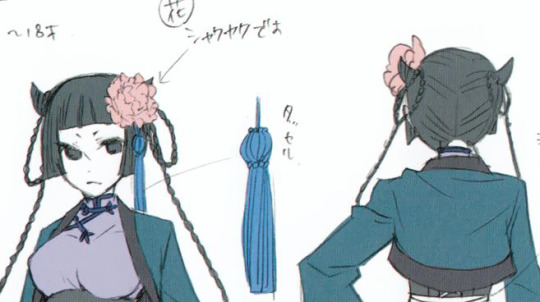
Let us start with her bangs. Her bangs are in fact surprisingly accurate, as late Qing dynasty women would wear their bangs in a variety of Bettie bangs trimmed well above the eyebrows. Having sides of the bangs growing longer framing the face was usual too, though they would be cut slightly thicker than Ranmao’s. Though, we don’t know how much hair Ranmao has, so I see no reason to alter it.

Twin braids are very much associated with the “China doll look”, but they seem to have been branded into our image of the “Chinese Girl” because it was the go-to look for unmarried women in Republic China (which is many years later than Ranmao’s time, and also has more surviving images.)

In Ranmao’s time, unmarried girls would either wear the bottom part of their hair down, or have everything tied into a single braid behind them. Girls who preferred a more feminine look would often decorate the sides or the top with flowers or other ornaments depending on their wealth.

Yana’s notes say that the flower in Ranmao’s hair is a Chinese peony, which is also called the Empress of Flowers in Chinese as well as Japanese culture. I could find sources on how the peony was the symbol of the Empress of China, and how one better avoid wearing any type of peonies around the Empress herself for fear of being suspected of disrespect. But I could not find any evidence of such flowers being banned for other people, so presumably it was more an ‘unwritten code of politeness’ rather than fashion law.
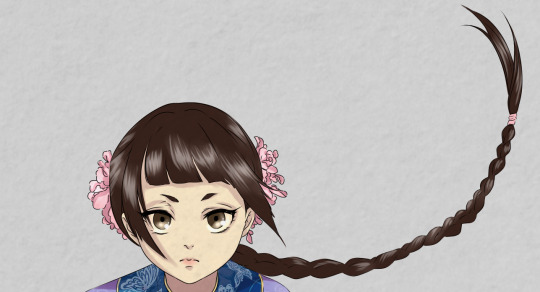
Hence, I kept the pink peony design for Ranmao, and decorated them in the way Qing women would have.

Neckline
By far the most interesting thing I learned from this redesign attempt was that the “mandarin collar” - the thing that pops up first in most people’s minds when thinking about Chinese fashion - was in fact not at all common.

In this academic work on Chinese fashion history, Finnane writes that the ‘high collar’ was “not a common feature of costume before the twentieth century.” Instead, most costumes would have had a round neckline.

Finnane, Antonia. Changing Clothes in China : Fashion, History, Nation. New York: Columbia University Press, 2008. p. 93
The ‘high collar’ gained popularity in early 1900s in China after the Europeans brought with them the beauty standard for high collars, as well as slim-fitted silhouettes. The Chinese increasingly adopted this type of collar and the slim silhouette (the well known ‘china dress/qipao/cheongsam’), and the relatively many early photos that survived helped engrave this stereotype into our minds.

Sleeves
I do not think it requires any mention, but 19th century Chinese fashion did not include boleros... For many of the original designs of Ranmao I can sort of see where Yana got that image from, but this bolero-look truly beats me.

The sleeves worn in the late Qing period were relatively wide, though they were starting to slim down over time. Late Qing women enjoyed much more flexible clothing rules than earlier Qing women, and the width of the sleeves was in great part determined by personal preference, season, but mostly one’s wealth.

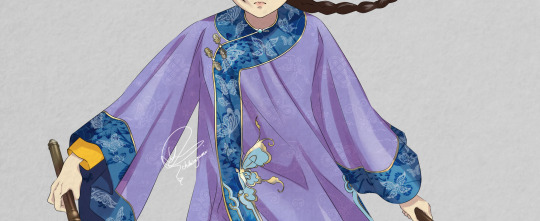
Needless to say, the larger the sleeves the more fabric and embroidery it would require, and thus more expensive. Also, the wider the more it would get into the wearer’s way.
I don’t know how much thought Yana put into Ranmao’s original design in relation to her function as elite bodyguard, but considering how the original has zero practicality and only serves to maximise Ranmao’s attractiveness, I have no qualms about giving Ranmao fairly large sleeves too. Besides, let us assume that Lau is responsible for providing Ranmao with clothes. Illegal money tends to fill the pockets quite deeply, I don’t think he can’t spare a few pounds for big sleeves.

Wider sleeves would expose much of ‘a lady’s precious skin’, as such a more fitted layer would have been worn underneath. (The sleeves under the wider sleeves obviously did not have to be orange-ish. This was merely coincidence that both my redesign and the visual source have this colour.)
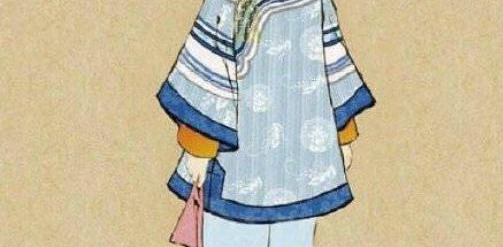
Silhouette
The figure hugging silhouette x Chinese clothes was - as mentioned above - not at all a thing in Ranmao’s time. In fact, the accentuation of the “female curves” was considered very inappropriate if not downright ugly in the Qing dynasty.


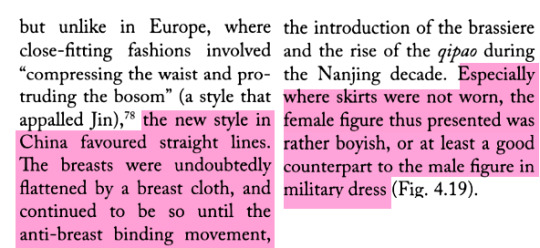
Finnane, Antonia. Changing Clothes in China : Fashion, History, Nation. New York: Columbia University Press, 2008. p. 94
Yana’s notes mention that the thing Ranmao wears is just an European corset and that that is the only thing ‘English’ about her attire.
Well... I don’t know where the idea that Victorians wore corsets on the outside comes from, but I myself admittedly was fooled by this a few years ago too... I promise you all now however, Victorians decidedly did not wear their ‘bras’ on the outside. I think even now this look is considered rather ‘questionable’ by most people.

Instead, Qing dynasty clothes were mostly cut wide and straight, loosely dangling around their bodies offering maximum comfort and space. You feared Ranmao killing you in her corset? Now tremble before her now blessed with maximised agility.

Trousers
Well... I considered ‘translating’ Ranmao’s attire to 2020 standard like I did for O!Ciel, but that would not be Tumblr-filter approved. Skirts so short they could be mistaken for a belt are nothing too surprising today, but wearing one with a split that deep is probably a bit too revealing even by today’s standards.

By the late Qing dynasty, men and women, rich and poor alike predominantly wore trousers. Long robes (skirts) were definitely in fashion too, but they were reserved for those who could afford to not have much agility. If you were a farmer, robes would not have been your first option. Perhaps the way long skirts were viewed by the Qing Chinese was not unlike the way we see them now; ‘more classy’ ‘more feminine’ and ‘less convenient’, but not the only way to express femininity.
In these pictures below we can see relatively rich women, married and unmarried alike, all wearing trousers.

Ranmao is predominantly a fighter, and as trousers are plenty feminine in Chinese fashion culture, I don’t see why she would not choose to wear trousers instead of a restricting long skirt. Hence I gave her a pair of trousers.

Shoes
Like I said before, “the shoes are correct...” But the anklets definitely are not!

Golden or silver anklets are something that are worn by very, VERY young children in China. Even to this day it is customary among many Chinese people to gift newborn children at least one piece of pendant, bracelet or anklet, for it is believed to bring the child luck. More practically, this piece of jewellery will become the child’s first piece of property then, which can be sold later SHOULD they ever run into a financially difficult situation.

These anklets or bracelets would not be removed from the child unless they have outgrown them, which happens fairly quick. Ranmao who is probably full grown should have outgrown them at least ten years ago. Hence, seeing these things on Ranmao would probably make it look like she is still wearing diapers or bibs.
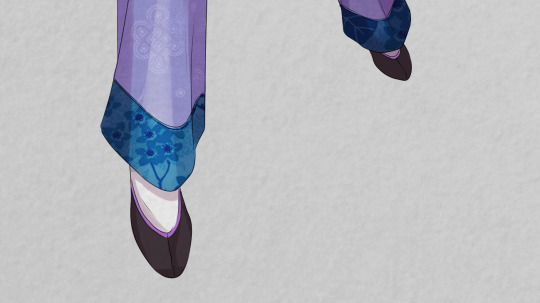
Chinese people would likewise not have worn shoes barefoot. Instead, they would have worn cotton socks which were mostly white.
DOUBLE HAMMERS
HERE COME THE WEAPONS! Luckily Yana wrote the following note or I would never have guessed what they are for my knowledge about Chinese weapons is next to nothing.
“These are【SUPER】heavy. They are weapons called 双錘 (double hammers) and they in fact exist. I heard these were used by power-type warriors.”
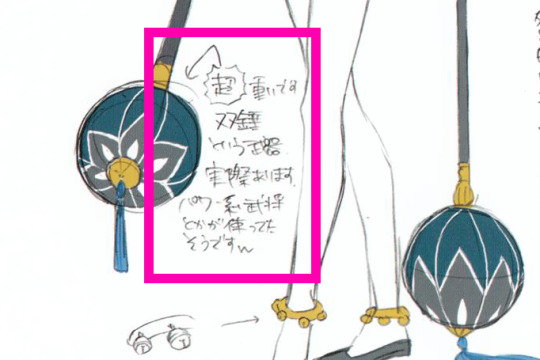
So, I googled 双錘 and it turns out that the type Ranmao is holding do indeed exist! But... only in fiction and theatre.

The hammers that were used in actual combat were either very thin and long, or short and plump. Such hammers were one of the most primitive metal weapons in China, and quickly fell out of favour among Chinese warriors when more practical weapons such as the metal spear, sword and bows were invented. The hammers mostly retained their value because of their weight in heroic tales and myths about legendary warriors and deities.
I don’t have the full details, but apparently according to some legends or myths, one of such big-ass hammers could deal a force of 200kg, and thus 400kg combined. Regardless of this being realistic or not, it sure does sound very cool! It is therefore no wonder this primitive weapon retains its popularity even today.

Nowadays when these hammers are used, they are either the blown up theatrical versions, or the smaller versions for the sake of preserving martial arts.
I had a bit of a dilemma as to which version to give Ranmao, but in the end I settled with the short and heavy ones because I wanted to keep the idea of this small and innocent looking girl wielding solid metal balls. Two cheer-leading sticks would simply not have the same weight, figuratively and literally.


Alright everyone! Did you enjoy my response to your votes? I hope you did ^^ Non-European fashion history really is not my strong suit, so my deepest apologies if I messed anything up.
Pray tell if I did, I am always happy to learn ^^
#Ran mao#ranmao#ran-mao#redesign#redesign prompt#art#my art#fan art#fanart#fan-art#Chinese clothes#UGGHGHHGHG non-European fashion REALLY is not my strong suit#BUT I learned a lot and I had fun!
1K notes
·
View notes
Text

I posted 3 916 times in 2021
148 posts created (4%)
3768 posts reblogged (96%)
For every post I created, I reblogged 25.5 posts.
I added 3 339 tags in 2021
#imperial china - 702 posts
#costumes - 479 posts
#fashion - 367 posts
#haute couture - 328 posts
#18th century - 304 posts
#qing dynasty - 275 posts
#women in history - 260 posts
#lmao - 248 posts
#hanfu - 202 posts
#19th century - 174 posts
Longest Tag: 140 characters
#i can't imagine the scene: him waking up and asking if he could cook and her encouraging him perhaps even helping him with shi lei's tastes?
My Top Posts in 2021
#5
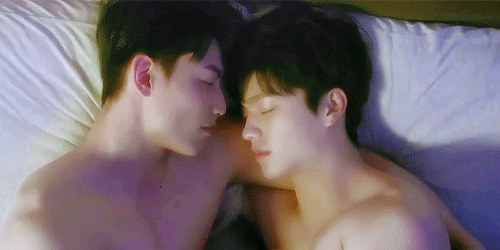
229 notes • Posted 2021-07-29 15:50:35 GMT
#4

233 notes • Posted 2021-04-03 15:54:10 GMT
#3
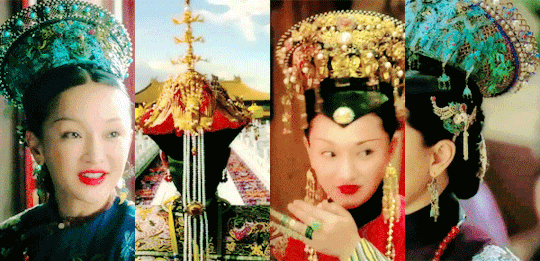
251 notes • Posted 2021-07-11 13:18:03 GMT
#2
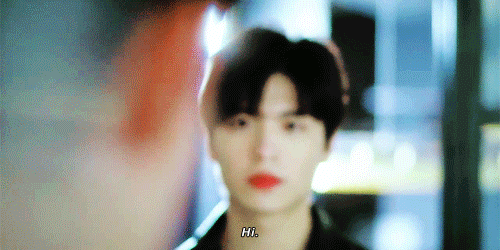
269 notes • Posted 2021-07-22 20:03:15 GMT
#1

275 notes • Posted 2021-03-06 16:54:26 GMT
Get your Tumblr 2021 Year in Review →
#my 2021 tumblr year in review#your tumblr year in review#it totally wraps me in a nutshell!#2021 was quite busy especially with blih and the cdrama challenge in summer!#yeah my gifs about blih received some interest#i just hope all my gifsets can have the same reception#😂😂😂#and more important: reblog posts!!!!#it's important for gif-makers!!!
2 notes
·
View notes
Text
My Favorite 2020 Dramas plus a few Honorable Mentions
In no particular order...
To Love

It’s not over yet, but already this is one of my favorites of modern Chinese dramas. The writing alone makes the story excellent in that it keeps you on your toes in every episode and keeps you engaged with the characters. Told from the two main leads’ POVs, it is a story of an undercover cop and a café owner who fall in love in the middle of his mission of a drug bust. It is a tale weaved from hard choices, complicated characters, and seemingly real life characters. It’s also a beautiful drama: full of color, excellent cinematography and lovely music.
I highly recommend it for anyone who wants to try out a underrated mature drama. I say mature for content (mainly for violence and drugs) as well for structure. This is NOT a bubbly, good-spirted drama. There is angst, pain, and conflict.
Qing Qing Zi Jin

I’m going to say it and mean it: My favorite drama of the year! I love it and have claimed the main leads to be “my babies” forever! The story is set in the Tang Dynasty of a mountain gang leader who comes to the capitol city to study at school not only to solve the mystery of ten years prior but to gain notoriety and fame. And let’s not forgot the love his life, a super strong (I mean that literally) girl who is a little shy at first, but then gains some backbone to go with those strong arms of hers.
It’s sweet, charming and lovely. And while that might sounds more like the perfect date, it’s not. There is plenty of drama infused: a jealous older sister, a cruel stepmother, a scheming royal, the truth of the FL’s mother, the secret of the ML’s true identity, as well as so much more.
I love every single episode and which it had ten more than its 40 episodes.
You Complete Me
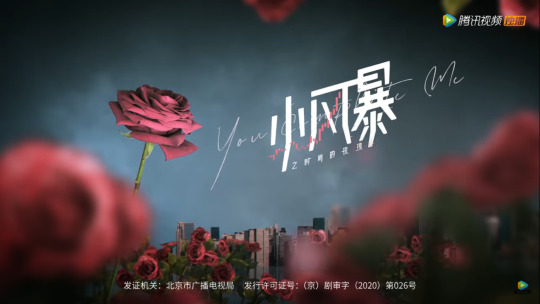
Another modern drama that is so underrated! This is less violent and emotionally complicated as To Love, but it does pack a wallop of feelings. It’s another revenge story (third one in a row, I might have a preference for these kind of dramas). The male lead wants to take down the rich businessman who was the cause of his father’s demise but on the way he falls in love with the man’s daughter.
It’s the most life-like drama so far on this list in that it’s very business-minded. There are quite a few scenes just discussing business tactics, money transactions, and meeting scenarios which all fly over my head. I can see that is a turn off for a lot of people, but believe me that it’s not all numbers and figures! There is a lot of story behind the suits and briefcases. The female lead is my favorite of the year: she’s a total badass who wants to earn her own way and won’t let anyone help or hinder her. She’s fantastic. If anything, watch the show just for her.
Note: I’m a sucker for the trope “I Did _(insert revenge act here)__ But Then I Fell in Love with You”. It’s the whole Good Girl and Bad Guy trope, and I love it so. The ML isn’t 100% bad, per say, but he does not have good intentions towards his enemy.
The Journey Across the Night

Yet another modern drama! This one is full of mystery, intrigue, and darkness (more so than To Love). Unlike the other dramas, this one is not about revenge. But Like QQZJ, The ML is searching for truth as well as going to school. He is studying psychiatry under this creepy professor and hunting for answers. His mother and older brother both were diagnosed with schizophrenia when they turned 24 and he searches to learn how to prevent his own eventual dissent into madness.
This is a psychological, thriller drama but it’s not as scary as you might think. It’s pretty tame as horror dramas can go, but there are several creepy scenes and a few sketchy characters. The ML is a nice guy (do they exist anymore?) who doesn’t believe ghosts, but he manages to get pulled into a new mystery along with his friends a lot. The FL is a bubbly, loud girl who takes an instant liking to the boy. She confesses to him quite a lot over the show and it’s quite cute to see him blush.
This drama does not have a story flow (other than the ML and his quest). It is developed by the several mysteries the ML and his friends solve which is very interesting. Every mystery impacts one of characters differently which gives more insight into them as well their interaction with each other. Friendship is a major theme in this show. It’s thrilling ride with plenty of mystery, but bring your tissues!
Oh! My Sweet Liar!

What an adorable costume drama also set in the Tang Dynasty. This is a family grounded story set around the rich and powerful Li family. The FL is a painter who infiltrates the Li Mansion to paint “the four arhats” for money. She encounters the eldest son who doesn’t trust her from the start. But things take an interesting turn when she suddenly announces that she’s pregnant with his baby!
It’s a comical, fun ride that is lead by a sweet couple as well as the second lead couple who are childish but also adorable. It’s the least dramatic of the dramas listed so far with its ML falling in love rather quickly with the FL and a powerful family that’s not quite as domineering as imagined. But it’s a sweet story.
Need a pick-me-up? I recommend this one.
Under the Power
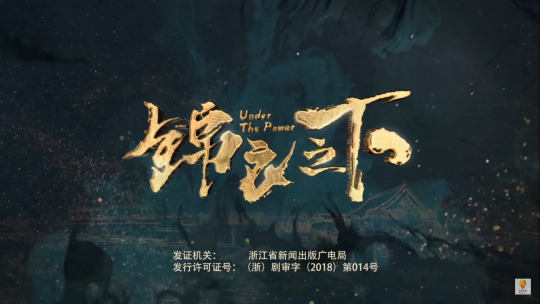
Crime fighting in the Ming Dynasty! It follows the trope of silly, but headstrong FL and the brooding loner ML. The girl is member of the local constabulary and she wants to fight against all injustice. The boy, a member of a special government enforcement team, endures her until he falls in love with her (wink wink).
The story follows the female constable and the government official teaming up to solve the case of the Disappearing Government Funds (play mysterious music here). They encounter multiple crime cases, battle different evil forces, even dip their toes into almost magical scenarios along the way. And they fall in love, of course.
It has its charm in the main couple’s cat and mouse interactions and slow burn love story. She comes from a poor background and he comes from the a government official lineage. They are night and day, but they click in a delightful way. Plus, there’s a ton of cool fighting scenes and a few likeable side characters too.
Eternal Love of Dream (aka the Pillow Book)
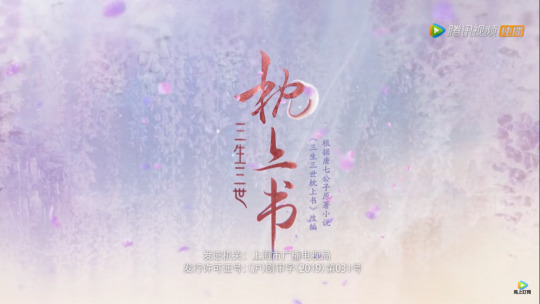
A fantastic follow up to the much-loved Ten Miles of Peach Blossoms with an appropriate story for everyone’s favorite minxy fox and the immortal who came from a rock. I love this story mainly because it gives depth to the shallow as a kiddie pool Feng Jiu from Ten Miles (I’m sorry, but she was not a favorite). She was such a crier that you needed an umbrella for a lot of her scenes. And Dong Hua was there too.
But then you actually see them have character and story and drama and a love story! And the chemistry is *chef’s kiss*. This drama is near perfection for its all mentioned previously except for a few minor things like it drags in some parts, a few side characters are boring (or the actors were switched from Ten Miles so I don’t quite care so much) and then it gets kind confusing in some parts.
Overall, a great fantasy drama with a well deserved ending.
...and now for a few honorable mentions!
Twisted Fate of Love

I’m on episode 11 so far and not quite fallen hard for it yet. I love Feng Xi (the scheming!!!) and all his questionable choices both to get Dong Yue and to get a promotion. But I don’t like Dong Yue much. She’s a weird mix of innocence and fighting spirit that I just don’t buy just yet. I will keep watching for their eventually love story.
The Heiress
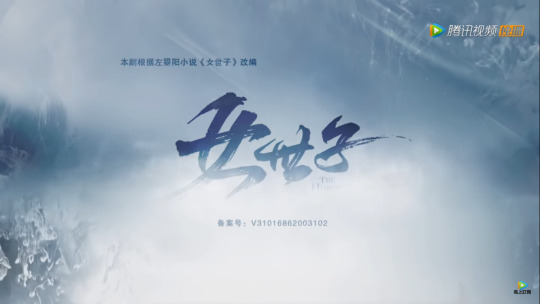
The scheming! The secrecy! The playacting! The love story! I like it all, but it’s just not enough to get on my favorites list. I did say previously it as my favorite girl-disguised-as-a-guy drama, but it’s not my FAVORITE drama this year. Still very enjoyable!
General’s Lady

A surprisingly fun drama with a cute couple! I’m about 16 episodes in and would like to finish it one day. I do like how the couple is married very soon and have to work on building their relationship over the courses of the show. It’s refreshing from other shows that have the reverse.
Dating in the Kitchen

Cute, cute drama! I probably would have put this on my favorites list but I haven’t finished it yet (I’m so behind in a lot of dramas). It touches on the older man/ younger woman genre, which is so rare is chinese dramas. And it’s done well. Not cringe-inducing because the two leads have beautiful chemistry. And there’s lots of food.
And that’s my list! I hope this inspires some of you to watch some very good dramas as well as stretch outside your comfort zone. I know I went out of my usual bounds of historical dramas and fell in love with some amazing modern dramas. Here’s hoping 2021 will bring lots of fun dramas for us to discover!
#cdrama#chinese drama#Dating in the Kitchen#under the power#the heiress#oh my sweet liar#to love#qing qing zi jin#general's lady#twisted fate of love#the journey across the night#eternal love of dream#you complete me
37 notes
·
View notes
Text
Abridged History of Qing Dynasty Han Women’s Fashion (Part 2: Kangxi Era)

Previous post
Led by one of the longest reigning emperors in Chinese history, the Kangxi era spanned more than half a century (1662-1722) and witnessed constant and numerous changes to Han women’s fashion. The fashion of this period had a distinct silhouette and various vibrant and unusual color palettes. Contrary to the lofty elegance and austerity of the Ming-Qing transition, fashion in the Kangxi era was much more lively.
The most significant change in this era happened in hairstyles. The front section of the 三绺梳头 hairstyle became taller and more voluminous, eventually needing the support of hair rats, creating the fabled 牡丹头 mudantou (“peony hair”). This is probably the most distinctive and recognizable feature of Kangxi era fashion.

Kangxi era artwork showing two women in peony hair. The back of the hairstyle with the coiled strand of hair and long twin swallow tails is visible.

Kangxi era woodblock print showing woman in peony hair. The popularity of red undergarments providing a flash of color was continued from the Shunzhi era.

Figurine from the era showing the front and back of the peony hairstyle.
In terms of clothing, the same garments that were popular prior in the Shunzhi era and among the Southern Ming states continued to be popular. The standard outer garments remained a robe with standing collar, a 马面 mamian skirt and an optional sleeveless jacket with a standing collar which closes at the center front. Standing collars were still commonly closed with metal clasp buttons or 子母扣 zimukou, though fabric buttons and tie strings weren’t unacceptable. A fabric sash could be worn around the waist. Skirts began to acquire increasingly high numbers of pleats. Foot binding was still en vogue, and red shoes seemed to be a popular choice for foot bound women throughout the 17th and 18th centuries. Red undergarments (the under-robes and pants whose edges would be visible, not necessarily the innermost layers) were still all the rage.


Kangxi era artworks.
While skirts were commonly white in this period, plain ones in other colors were also fashionable.
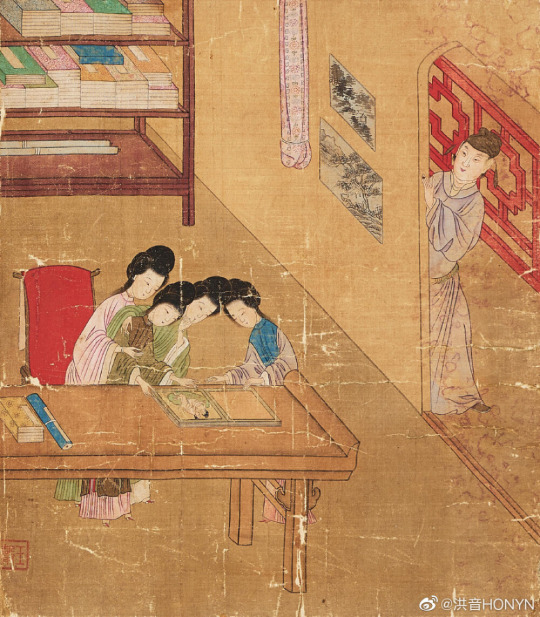
A newly popularized accessory was the 云肩 yunjian or the cloud collar. These were large, flat collars that usually took a quatrefoil shape and were worn around the neck.

Undated example of a cloud collar laid flat, to show its construction.


Section and closeup of painting 乔元之三好图 by 禹之鼎 Yu Zhiding, 1676, showing women musicians wearing cloud collars. It can be seen that they are wearing something else on top of the cloud collar, a smaller collar with petal like shapes and an attached standing collar, something apparently called 阁鬓 gebin. This would become a wardrobe staple in the 18th century.
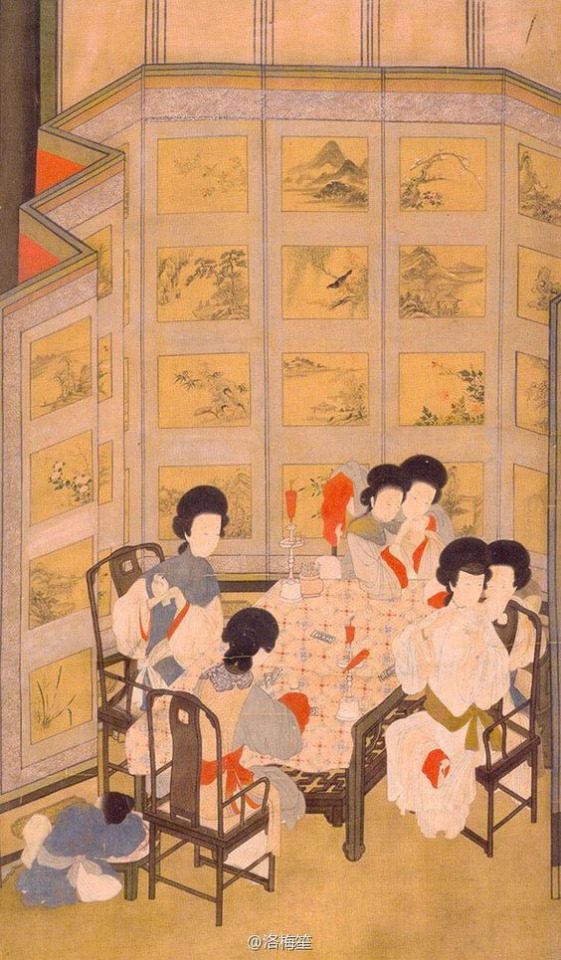
A group of women playing cards, the one with her back to us is wearing a cloud collar. We can also see parts of the red under-robes and pants.

Kangxi era woodblock print showing a lady wearing a cloud collar (the contrasting color of the standing collar could be because it’s attached to the cloud collar instead of the robe). It should be noted that while Han men in real life wore Manchu fashion, in artworks, theatrical performances and while lounging at home they were commonly depicted as wearing “Han style” garments, which were less accurate late Ming fashion and more of a unique Qing style of Han costuming, developing what could be considered Han men’s fashion in the Qing. It’s just that these clothes are limited to the realm of artistic representation and not worn on real, everyday occasions.

This is a more realistic depiction of menswear from the same period; the womenswear depicted is congruous with that in more stylized artworks where men wore Han style garments.

We also start to see the popularity of 抹额 mo’e, a headband with a pointed front and oftentimes a round jewel, worn low on the forehead.

Kangxi era painting, the seated lady is wearing a mo’e.

Snippet of a painting ca. 1670s or 80s showing a lady wearing mo’e. You can also see how her robe closes down the center front instead of under the right armpit, as there is no diagonal line across the chest area.
The 披风 pifeng, a long sleeved coat that closes at the front with a single button or tie string, oftentimes with a strip of fabric around the neck opening, was popular at this time as well. Unlike in the late Ming when the protective fabric strip was commonly white or otherwise a single color, in the early Qing it could be patterned and decorated.

Snippet of a Kangxi era painting showing a lady wearing mo’e and a paddy field robe.
Standing collars could now be in a contrasting color to the rest of the robe. I’m not sure if this was achieved by making the collar out of a different colored fabric, or by wearing a standing collar robe with the same color throughout, and then wearing an additional collarless jacket in a different fabric.
Decorative elements began to reappear on skirts, in styles wholly different and alien to their Ming Dynasty predecessors. A feature of this time was the addition of a square or circular patch of embroidery to the front and back 裙门 qunmen (the unpleated sections of a mamian skirt). This was likely made possible by the rising popularity of embroidered patterns as opposed to woven, brocaded ones in the Ming, as embroidery was less restrictive and allowed freeform designs of patterns and motifs. As for robes, a common decorative pattern was 团花 tuanhua, consisting of roundels or circular shapes filled with motifs like flora and fauna, animals, script, geometric shapes and others. Roundel patterns originated in Ming Dynasty court dress, which were continued in many styles of Qing court dress, and were commonplace as a decorative layout for Han women’s clothes of the 17th and 18th centuries.

Kangxi era woodblock print showing a vibrantly dressed woman. Her robe has floral tuanhua decorations (presumably embroidered) and her skirt has the square decorative patch.
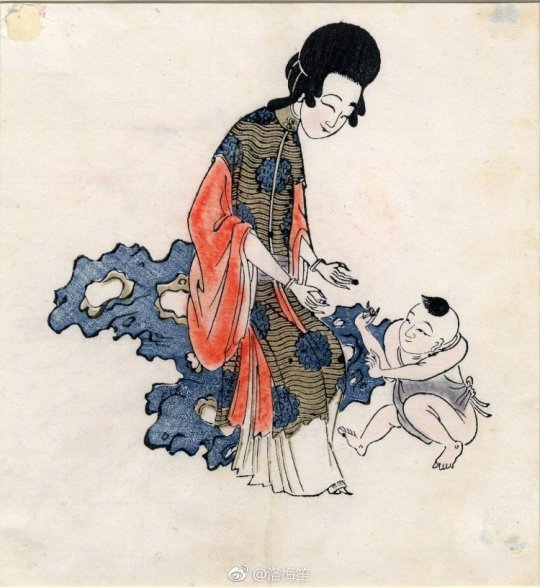
Woodblock print showing a sleeveless jacket with tuanhua patterns set against a wavy patterned background.

Kangxi era woodblock print. The woman to the left wears a skirt with a circular decorative pattern, the women to the right wears a mo’e and a pifeng. The man’s stylized Han robe has clear tuanhua patterns.
As we draw closer to the 18th century, the volume of women’s hairstyles began to move toward the back, and we start to see more frequent appearances of the pifeng. Robes also became longer, hitting ankle length and almost concealing the entire skirt. The transition to the Yongzheng and early Qianlong era aesthetic was underway.

闲敲棋子图 by Yu Zhiding, 1697. The volume of the pompadour moved toward the back of the head, and the pifeng is of a "paddy field” pattern. 水田衣 shuitianyi or “paddy field” robes were popularized in the Kangxi era, robes made of patched geometric pieces of fabric.

Late 17th century artwork showing the latest fashion. We can see how densely pleated the skirts are.
#17th century#18th century#kangxi era#qing dynasty#chinese fashion#abridged history of qing dynasty han women's fashion#fashion history
130 notes
·
View notes
Note
Hello! So before I ask, I just want to say that you have an incredible tumblr and I want to thank you for answering questions about Hanfu, it helps a lot! Anyway, I have two doubts about Hanfu. The first one may be silly, but I wonder if in some dynasty fashion women wore earrings. The second question is whether clothing during the Qing Dynasty can be considered Hanfu. Sorry for my bad english!
Hi, thanks for the questions! (image via)

For your first question, please see my post on earrings here.
As to whether clothing during the Qing dynasty that lasted almost three centuries (1644-1912) can be considered hanfu: the simple answer - no. The more nuanced answer - it depends.
First of all, some types of hanfu & hanfu accessories were worn from the Ming dynasty into, and throughout, the Qing dynasty without changing their basic forms. Some examples include: religious clothing like Daoist robes, Chinese opera costumes, children’s clothing like Baijiayi (One Hundred Households Robe) and animal hats & shoes (e.g. Tiger hats), yunjian (cloud collars), and mandarin squares & rank badges. These items were commonly worn during the Qing dynasty, and are considered part of hanfu.
What did change was men and women’s everyday clothing. When the Manchu rulers of the Qing dynasty took power, they imposed their fashions on Han civilians. Wikipedia has this to say (x):
“For a period of time, under the dynastic laws after 1636, all Han Chinese were forced under penalty of death to adopt the Manchu male hairstyle, the queue, and dress in Manchu [clothing] instead of traditional [hanfu]. However, the order for ordinary…Han civilians to wear Manchu clothing was lifted, and only those Han who served as officials or scholars were required to wear them…By the late Qing…a great many commoner Han men wore Manchu male attire. For women, Manchu and Han systems of clothing coexisted.”
As you can see, while Han men’s fashion changed quite abruptly, Han women’s fashion evolved more gradually, taking on more Manchu influences as time passed. Let’s take a look at this timeline (source) of the evolution of Han women’s clothing during the Qing dynasty, from the late Ming dynasty to the beginning of the Republican era.
Rows 1-3: Han women’s clothing during the early Qing dynasty (rows 2-3) was a relatively unchanged continuation of late Ming dynasty hanfu (row 1). Note the hanfu styles of changshan, pifeng, and bijia:
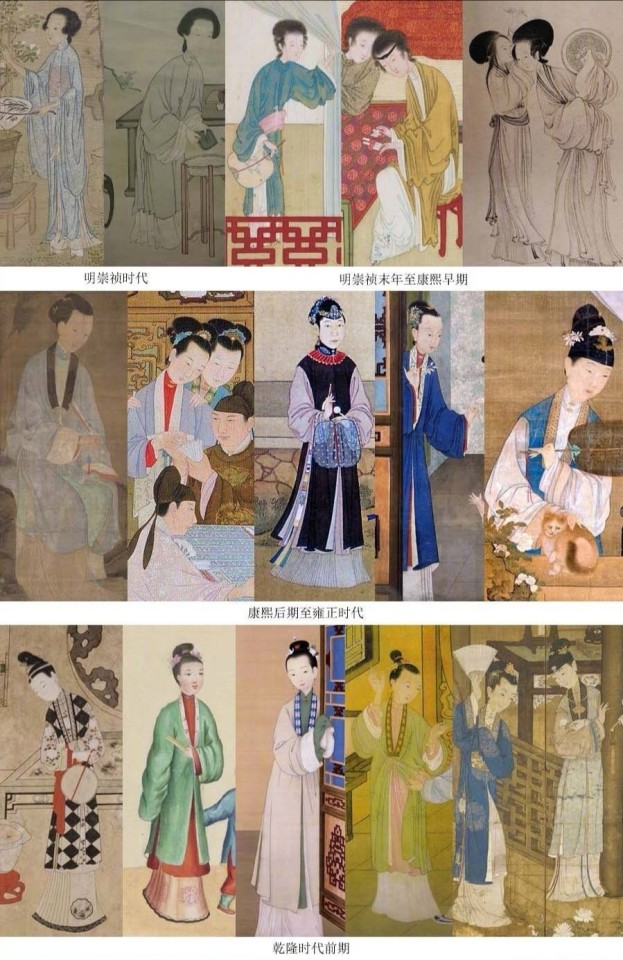
Rows 4-6: As time time passed, more Manchu elements were incorporated. Note the changing shape of the collar & sleeves, and the use of wide decorative borders (rows 5-6):
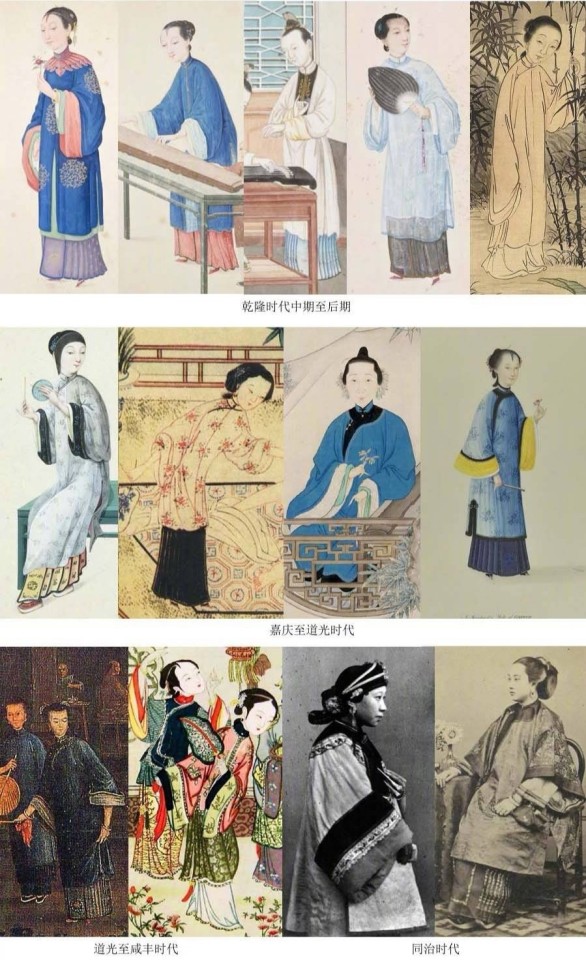
Rows 7-9: Women’s clothing of the late Qing is markedly different from that of the early Qing. The collars, sleeves, silhouettes, and decorative borders have taken on the distinct forms that most people today associate with Qing dynasty fashion:

Therefore, the modern hanfu revival movement considers Han women’s clothing of the early Qing dynasty to be hanfu, as it overlaps with that of the late Ming dynasty (1, 2):
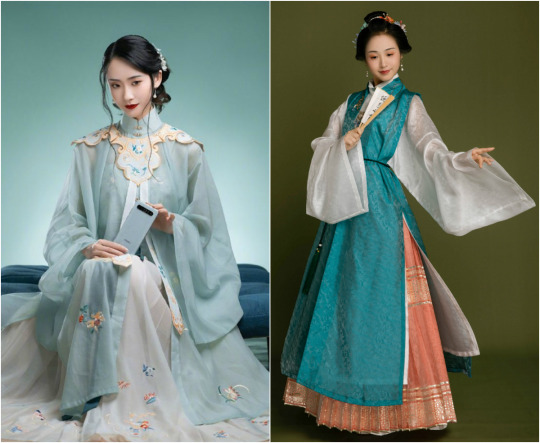
However, Han women’s clothing of the mid-to-late Qing dynasty is not considered hanfu, due to the many changes it underwent. Rather, it is in the separate category of “Qing Han Nv Zhuang/清汉女装” - “Han women’s clothing of the Qing dynasty”. The image below shows the similarities and differences between Han women’s clothing of the late Qing dynasty (left), and Manchu women’s clothing of the Qing dynasty (right). The main difference is that Han women maintained the two-piece top & skirt style from the Ming dynasty, while Manchu women wore long, one-piece robes. The other elements, however, are quite similar. Note: Manchu clothing is called Qizhuang/旗装. The “qi/旗”in qizhuang is the same “qi” in qipao, and means “banner”. It refers to the Eight Banners system of the Qing dynasty, and is shorthand for the Manchu people (1, 2):

For more detail on the differences between Ming dynasty hanfu and Qing dynasty clothing, @guzhuangheaven has a great post here.
Here are additional resources on hanfu & its relation to Qing dynasty fashion:
My “Qing dynasty” & “Qizhuang” tags
The “Notes on Qing dynasty costumes” series by @guzhuangheaven
“The Brief History of Qing Dynasty Clothing” article by Newhanfu
Please note that I am no expert on Qing dynasty fashion, and welcome any corrections/feedback ^^
Hope this helps!
#hanfu#earrings#Han women’s clothing of the Qing dynasty#清汉女装#qizhuang#Qing Dynasty#>500#history#reference#ask#reply#jesusestavoltando#chinese fashion#china
912 notes
·
View notes
Photo
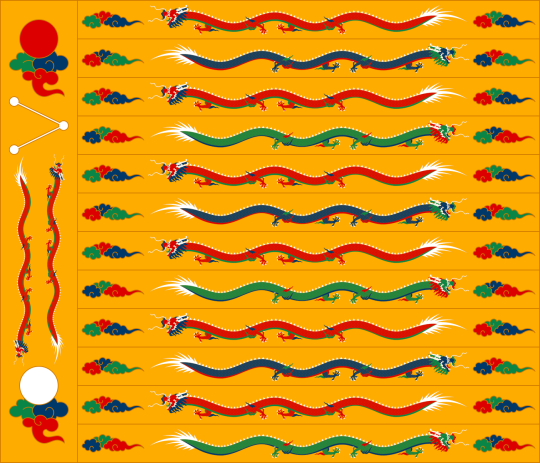
Pre-Qing Ancient China's imperial flag: the Great Chang
from /r/vexillology
Top comment: Warning: LONG The Great Chang banner (大常/太常) is also called Banner of Celestial Bodies (辰旒). This banner reigns supreme among other banners specified in the [Zhou Dynasty](https://en.wikipedia.org/wiki/Zhou_dynasty)'s ritual system (which was still adopted and implemented by later dynasties. The "great" part is written either 太(tai) or 大(da), but their meanings are essentially identical. If we were to treat an absolute monarchy's royal banner/standard as the state's national flag (anyone remember that Russian yellow flag with a black double-headed eagle holding four maps?), then yeah, this flag would be the Ancient Chinese kingdoms' flag. In summary: * 《[唐通典·职官七·太常卿](https://ctext.org/text.pl?node=553367)》: 颜师古曰:太常者,王之旌也,画日月焉。 [*Comprehensive Institutions of Tang*](https://en.wikipedia.org/wiki/Tongdian)*·Government Offices part 7·Minister of Ceremonies*: Tang historian [Yan Shigu](https://en.wikipedia.org/wiki/Yan_Shigu) said: **The Great Chang is the monarch's flag, with the sun and the moon illustrated on it**. \*Note that the minister of ceremonies (太常/太常卿) shares the same name as the flag itself. The paragraph from the *Rites of Zhou* below assigned different Chinese characters to what in English can be described as just flags. Basically it's like "this flag (for this usage) is called this" so I'll just use the pinyin Chang for convenience. * 《[周礼·春官](https://ctext.org/rites-of-zhou/chun-guan-zong-bo)》:司常:掌九旗之物名,各有屬,以待國事。日月為常,交龍為旗,通帛為旃,雜帛為物,熊虎為旗,鳥隼為旟,龜蛇為旐,全羽為旞,析羽為旌。及國之大閱,贊司馬頒旗物:王建大常,諸侯建旗,孤卿建旃,大夫、士建物,師都建旗,州里建旟,縣鄙建旐,道車載旞,斿車載旌。 [*Rites of Zhou*](https://en.wikipedia.org/wiki/Rites_of_Zhou)*·Offices of Spring*: Ceremonial Minister of Chang: they are responsible for handling the nine banenrs, which belong to various groups, in order to carry out ceremonial activities. Banners featuring the sun & moon are called Cháng (常). They are for the monarch. Banners featuring (only) the alternating dragons are called Qí (旗). They are for the vassal lords. Banners with their field and decorations made with pure red fabric are called Zhān (旃). They are for the high-position court officials. Banners with their field made with pure red fabric but with their decorations made with white fabric are called Wù (物). They are for the scholar-officials. Banners featuring bears and tigers are also called Qí (旗). They are for the officials governing the outskirts. Banners featuring raptors are called Yú (旟). They are for the officials governing the inner cities. Banners featuring turtles and snakes are called Zhào (旐). They are for the officials governing Bi's (500 households) and Xian's (2500 households). Banners made with all colorful decorative feathers are called Suì (旞). They are for the monarch's carriage pulled by 20 horses. Banners made with selected handful of the feathers are called Jīng (旌). They are for the monarch's carriage pulled by 36 horses. The [*Qing Imperial Encyclopaedia*](https://en.wikipedia.org/wiki/Gujin_Tushu_Jicheng) (欽定古今圖書集成) can come in handy since they compiled many previous dynasties' documents together. [The Three Rites Illustrated](https://zh.wikisource.org/zh-hant/%E6%AC%BD%E5%AE%9A%E5%8F%A4%E4%BB%8A%E5%9C%96%E6%9B%B8%E9%9B%86%E6%88%90/%E7%B6%93%E6%BF%9F%E5%BD%99%E7%B7%A8/%E6%88%8E%E6%94%BF%E5%85%B8/%E7%AC%AC269%E5%8D%B7) (三禮圖) section has some pictures and offers these sources: * 《周礼·春官·巾车》:王乘玉輅,建太常十有二斿以祀。 *Rites of Zhou·Offices of Spring·Curtained Carriage*: When the monarch travels by his carriage, the Great Chang with twelve stripes is hoisted. * 《儀禮注疏·卷十·覲禮》:王建太常,縿首畫日月,其下及斿交,畫升龍降龍。 *Annotations on the* [*Book of Etiquette and Ceremonial*](https://en.wikipedia.org/wiki/Etiquette_and_Ceremonial)*·Volume 10·Etiquettes of Presenting at Court*: The monarch flies the Great Chang, with the sun and the moon illustrated on hoist, and with rising and descending dragons drawn underneath it and on the stripes. About the inclusion of stars (can be seen in many illustrations), the below document may support that: * 《孝經注疏》:案鄭注《周禮·司服》稱,至周而以日、月、星辰畫於旌旗,所謂「三辰旂旗,昭其明也」。 *Annotations on the* [*Classic of Filial Piety*](https://en.wikipedia.org/wiki/Classic_of_Filial_Piety): According to Han scholar [Zheng Xuan](https://en.wikipedia.org/wiki/Zheng_Xuan)'s annotation on the *Rites of Zhou·Administrator of Costumes*, during Zhou Dynasty the sun, moon & stars were drawn on the banner, signifying that "The banner of the three celestial bodies demonstrates brilliance (this part in quote marks originated from [*Zuo zhuan*](https://en.wikipedia.org/wiki/Zuo_zhuan))." Detailed measurements were not really available. I only managed to find the proportion of horizontal lengths from the [*Book of the Later Han*](https://en.wikipedia.org/wiki/Book_of_the_Later_Han). Artists didn't really strictly followed them. * 《[後漢書·志·舆服上](https://zh.wikisource.org/wiki/%E5%BE%8C%E6%BC%A2%E6%9B%B8/%E5%8D%B7119)》:天子五路,(...), 建太常,十有二斿,九仞曳地,日月升龍,象天明也。 *Book of the Later Han·Records on Clothing part I*: The monarch has five carriages. (...) \[The carriages\] hoist the Great Chang, with twelve nine-ren-long stripes touching the ground. It features the sun, moon, and rising dragons, symbolizing the heaven's brilliance. * 《[後漢書·志·禮儀下](https://zh.wikisource.org/wiki/%E5%BE%8C%E6%BC%A2%E6%9B%B8/%E5%8D%B796)》:旂之制,長三仞,十有二游,曳地,畫日、月、升龍 *Book of the Later Han·Records on Etiquettes part III*: The flag is three rens long, with twelve stripes touching the ground. The sun, moon, and rising dragons are illustrated on it. The sun & moon are the most significant components. Various historical examples at least maintained that. What other things should be added onto it seemed to vary. Some other resources for reference: * [All the Great Changs illustrated in the two Ming paintings of *Departure Herald Imperial Procession Leaving the Palace* & *Return Clearing Imperial Procession Returning to the Palace* (出警圖&入蹕圖)](https://i.imgur.com/l5afoqu.jpg) * [*Collected Rites of Great Ming* (大明集禮) Volume 43 (page 8 on this PDF)](https://archive.wul.waseda.ac.jp/kosho/wa04/wa04_06292/wa04_06292_0032/wa04_06292_0032.pdf) * [The Nine-Banner System Diagram from the Ming book *the Seven Classics Illustrated* (七經圖](http://gmzm.org/bbooks/%E7%BB%BC%E5%90%88%E7%B1%BB/%E4%B8%83%E7%BB%8F%E5%9B%BE/%E5%8D%B711%E8%87%B312/index.asp?page=59)[)](http://gmzm.org/bbooks/%E7%BB%BC%E5%90%88%E7%B1%BB/%E4%B8%83%E7%BB%8F%E5%9B%BE/%E5%8D%B711%E8%87%B312/index.asp?page=59) * Bonus: 16-17th century Japanese painter [Kano Sansetsu](https://en.wikipedia.org/wiki/Kan%C5%8D_Sansetsu)'s [*Song of Everlasting Regret Emaki*](https://www.irishtimes.com/culture/art-and-design/visual-art/art-in-focus-song-of-lasting-sorrow-by-kano-sansetsu-1.3673449) has a [Tang official holding the Great Chang in his hand as if it's a regular flag](https://i.imgur.com/RiJDKlt.png).
24 notes
·
View notes
Text
Visiting Salem
A few years ago I traveled to Salem for Halloween week. It was a fun trip but not at all the quaint town I had expected. And it was busy. Salem eagerly leans into its witch history and new age spiritualism, sporting many psychic readings and occult shops. To be honest, a large part of my stay was spent walking, shopping, and eating so I didn’t get to visit as quite as many museums as I would have liked. I’ve included a brief review of some of the places I stopped in at while I was there:
Jolie Tea - this was tucked away from the Essex Street pedestrian mall, which made it the perfect place to escape the crowds and blustery wind. They had a selection of seasonal tea blends made in shop. I stopped in several times and took several pounds of tea back as a visiting gift for my aunt. I know it’s an odd compliment but I’m in love with their upholstery and the wallpaper in their restroom. Very limited seating (only 3 tables, one of which only seats two people), but quiet enough at the times I went as to not be a problem.
Count Orlok’s Nightmare Gallery - located on Essex street (the main thoroughfare, foot traffic only) this gallery houses memorabilia and trivia from classic and modern horror cinema. I recommend it if you fancy yourself a horror movie buff. Tickets were $9 for adults and did not need to be purchased in advance. The tour is self guided, walk in any time.
O'Neill’s Pub & Restaurant - honestly I popped in here just intending to use the facilities and get off my feet for a bit but they sell the best pumpkin ale I’ve had to date. The rim is dusted with cinnamon sugar and the head is dusted with a crescent moon of spice. I enthusiastically returned twice a day for the duration of the trip (I was on holiday after all). Their shepherd’s pie was quite good and the waitresses were happy to share insider advice on the best places to park, how to avoid traffic, etc.
Howard Street Cemetery - I visited this cemetery under the impression that the headstone for Giles Corey was there. It wasn’t. There was a memorial at one time but it was toppled by a vandal in 2015. Nevertheless it was a nice, quiet place to stop and take a breather from the crowds.
The Witch House - this is a bit of a misnomer as the house belonged to Jonathan Corwin, one of the judges of the trials. The house is the only structure left in the city that has direct ties to the trials and gives a much more authentic impression of daily life. The tour is self guided but there are volunteers stationed throughout ready to talk about particular items or history of the individuals that resided there. They have a limited capacity they’re required to stick to because of the house’s age so you may be in for a bit of a wait if you catch it during a busy hour. Tickets are about $10 for adults, sold in the gift shop.
Salem Witch Museum - They start the tour by seating visitors in a dark theatre. A recording plays, lighting up vignettes at scheduled points. These vignettes are maybe roughly 9 feet up from where you will be seated, not in sequential order, and cover a full 360° so swiveling your head up and around to find it is necessary. The recording and displays are rather dated; my guess is that they haven’t been changed since the museum’s founding in 1972 (to be honest I was rather expecting Vincent Prince to narrate). After this the group is lead into a small gallery with various placards and pop culture and news printouts. A guide will deliver a brief monologue and then you are free to view the gallery or filter into the gift shop.
I was rather perturbed that the museum spent effort linking hysteria of the Salem witch trials to McCarthyism (and any other time the American media described a thing as a “witch hunt”) but did not give but the briefest lip service to the misogyny that drove the witch trials and the selection of its victims. Anxiety about attacks from indigenous people were mentioned, but nothing of the political tension of territory and property lines, the disputes between Salem and its many pastors, or the institution of witchcraft as a prosecutable offense in a court of common law by King James. For a museum on the trials it was very light on the details. I found more information available in the gift shop’s surprisingly thorough selection of books. You do have to buy tickets ($21 adults) somewhat in advance for tours that rotate on (I think) 45 minute intervals.
Peabody Essex Museum - The Peabody Essex Museum is huge and hosts art and history exhibits. When I visited they had an exhibit on Qing Dynasty empresses and had just finished reconstructing brick by brick, tile by tile, a real Qing Dynasty ancestral home imported from Huizhou, China, Salem’s sister city. General admission is $20 for adults.
The Hocus Pocus House - The house used for the exterior of Max and Dani’s in the 1993 movie is a popular stop but it is quite a long walk away from the main tourist hub. I’m sure there are bus tours that would take you there, but like the spendthrift I am, I hoofed it. You can’t enter the house as it is a private residence so taking photos from across the street is the best you can get. The benefit of walking are the scenic views (at last! The quaint town I had imagined!) and meeting a neighbor a few doors down. She had fashioned a hedge from seashells and had delightful watchdog whose name escapes me, save that it was compound and started with “Sir.” I caught her outside gardening - or rather she caught me - and had a chat about the house, tourists, and living in Salem.
Witch City Mall - free multi-story parking! Get there early.
The Coven’s Cottage - Tools, ingredients, books, and more with an exclusive focus on Asatru.
HausWitch Home + Healing - prime example of the self-care industry meets new age spiritualism.
Artemisia Botanicals - Every powdered or raw ingredient you could likely hope for. I saw advertisements for their tea reading service but none was offered when I visited.
Hex Old World Witchery - a sister store to the one in New Orleans. It sells tools, spell ingredients, enchanted candles, jewelry, and some very jaunty pointed hats for ladies and gents.
Life Alive Organic Cafe - Organic vegan cafe. It has the Sanderson Sisters painted as vegetables on their window.
Opus - A fusion restaurant. The food was amazing and the service was great. They have live shows in their basement level. A perfect place for cocktails.
Adriatic Restaurant - Mediterranean and Italian fare. Decent, but pricey.
Caramel Pasteries & Macarons - Easily the best macarons in town. They also sell ice cream and a limited selection of coffee and tea.
The Satanic Temple Headquarters - Baphomet had just returned from his extended stay in Arkansas. The connected Salem Art Gallery and library was also open, and there were some rather striking vine and wicker sculpture work to greet you. And as expected, the people were quite friendly and helpful with recommendations for what else to do and see in Salem. The only downside is that it is a bit of a hike from downtown, but a much shorter one than the Hocus Pocus house. Self-guided tour is $15 for adults.
Street vendors - there are many of these out and about close to Halloween. You can buy whole bags (and whole bags only) of apple cider donuts and other goodies. Not something I normally go for but it was enjoyable. Bring cash.
Additional notes
There are loads of people in costume days before Halloween. If you are shyly deliberating on whether or not to pack a costume, you needn’t think on it further. Do it and have fun, my darling.
However, I should warn you that if you are one of those that plans to wave a movie replica wand at traffic while shouting bad Latin, I can assure you that you aren’t the first to attempt this and the drivers will not be patient with you. Better to hustle along.
Salem has a noise ordinance that goes into affect at 10 PM on Halloween night. According to the local waitresses most folks don't begin to trickle into town until 10 AM or so that day.
Essex street is cobbled, please wear comfortable shoes.
Shop around! There are many shops selling largely the same merchandise. By and large you'll see the same prices but if you've got a sharp enough eye you can save yourself a bit of cash.
Reserve your stay, wherever it is, AS SOON AS POSSIBLE. I reserved in January and still had to book a room 20 minutes away, which required a car rental.
Speaking of which, if you're driving in from outside Salem, the lanes merge and disappear frequently and it can be a little stressful. Most of the drive into Salem is single lane through neighborhoods - school bus traffic included.
The temperature in late October is mild but the wind chill coming off the sea makes it feel at least 10°F cooler. And it’s quite windy - wear your hair up. Preferably add a hat lest you show up on someone’s doorstep looking like Sadako, as I did.
#travel#traveling witch#salem#witchblr#halloween#hocus pocus#satanic temple#salem massachusetts#samhain
30 notes
·
View notes
Note
In Yanxi Palace, I noticed that in the side slits of the concubine/consorts casual dresses, there was a ribbon that hung to the length of the skirt. What is it called, please? And was it also found on Ming dynasty clothes as well?
I think you’re referring to this thing?


I think this is called piaodai 飘带. It probably derives from the piaodai on Ming dynasty clothes which were originally actually used to tie clothes shut, but then evolved to become more decorative.



You actually see more decorative piaodai in the clothes of Han women in the Qing period (清汉女装). There is a whole type of skirt called the piaodai skirt (飘带裙):
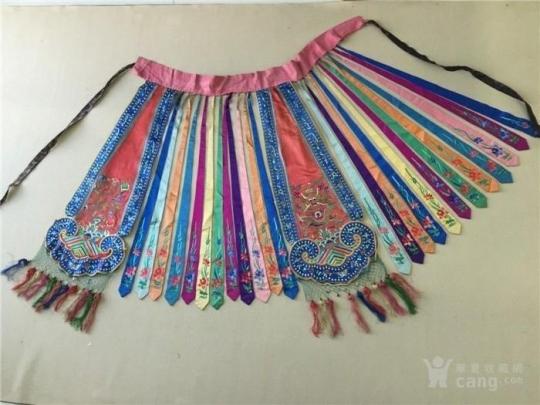
Piaodai can often also be elaborate embroidered:
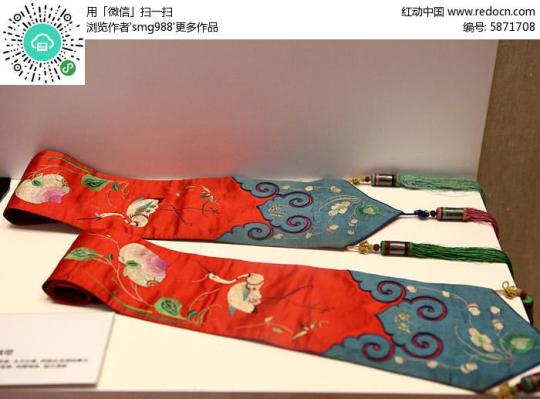
#ask#the story of yanxi palace#qing dynasty#notes on qing dynasty costumes#延禧攻略#theitgirlblog#clothing reference#clothing hair make up
172 notes
·
View notes
Text
Mulan (2020): A Scathing Review
Or, an extremely long rant by two extremely mad Chinese girls.
Before we (@hotaruyy and @meow3sensei) watched Mulan (2020), we didn’t expect too much, since the director and screenwriters aren’t Chinese (even though they claimed to want to be more culturally accurate). But holy shit, this film didn’t even fulfill our exceedingly low expectations (and we’re speaking as people who didn’t mind the loss of the musical aspect because look at the Beauty and the Beast live action). Our review will focus on our critiques of the presentation of different aspects of Chinese culture in Mulan (2020).
The Chinese Aspect of the film was especially infuriating to us as a Chinese audience. Disney emphasises that many of the changes made to the film in comparison to the animated film were to accommodate backlash regarding cultural and historical inaccuracies from Chinese audiences, but what we saw on the screen showed otherwise.
On Set Design (By a slightly irritated Architecture student)
Mix and match of architecture from multiple dynasties, which removes a lot of the sense of realism and authenticity from the film
Tang-style architecture is used (and if we’re being specific, Tang with hints of Song Dynasty) in the Imperial City’s set, which one would assume depicts the time period in which the movie is set in. Identified by the wooden balustrades, relatively simple and small dougong, vertical lattice windows, wooden piles for waterfront, organic shapes in landscape architecture etc. (fig. 1)
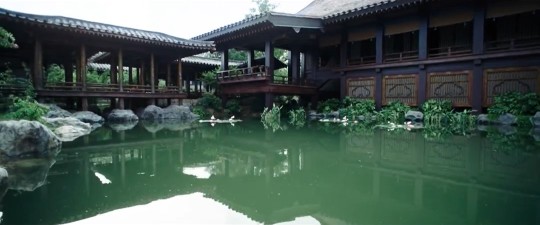
fig. 1 - Scene in film
Understandably, information on architecture before Tang (618-907AD) is scarce, so I do think there was an attempt at referencing the original poem that was written during the Southern and Northern Northern Wei Dynasty 南北朝北魏 (386-581AD). Taking creative liberty here makes sense.
That being said, the film didn’t care for retaining a consistent style of architecture, resulting in a wormhole of a set that somehow spans five different dynasties. Only two examples will be listed to avoid an entire essay :)
Exhibit A. Mulan’s home in Hakka Tulou 客家圍土樓 (fig. 2) (roughly translates to Hakka Mud Towers), which originated in the Song and Yuan dynasties (960-1368AD), and started maturing in the late Ming dynasty. (Why use something that didn’t even exist when the Ballad was written and by doing so, physically place Mulan in Fujian?? Just put her in an ambiguous village like how the animation did??). Somehow Tulou started existing before the Hakka clan migrated down south :) To put it simply the presence of Tulou is a locational and historical bug. The jump from the Hakka Tulou to the Tang-styled Imperial palace (fig. 3, which is strictly speaking a hybrid of different styles but I’d argue still mostly Tang) in the opening scenes is only a taste of the amount of inconsistencies later seen in the film.

fig. 2 Scene in film - Hakka Tulou
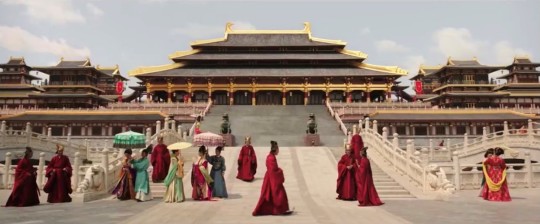
fig. 3 Scene in film - the Imperial Palace
Exhibit B. This scene (1:20:14) showing Qing Dynasty architecture in what is supposed to be a Tang Dynasty setting, identified by more elaborately decorated dougong 斗栱 (fig. 4 a key feature in the structural system in Chinese architecture, referring to the interlocking structure that sits on top of each column; at least three different kinds of dougong from three different dynasties have been spotted in the film).

fig. 4 Examples of different Dougong in Ancient Chinese architecture (top left being a good example of Tang-styled Dougong)
An insignificant building is not supposed to have more glamorous and larger dougong than the Imperial Palace, not to mention the lack of decorative dougong at all during the Tang Dynasty.

fig. 5 Scene in film that features a building with dougong

fig. 6 Shenyang Imperial Palace built in the Qing Dynasty
An actual Qing Dynasty Palace (fig. 6), for reference, and a random scene from the film (fig. 5). Note the larger dougong both fig. 5 and 6 (the ratio of dougong to column is significantly larger) with more layers of interlocking segments, as compared to the Tang-styled dougong that we pointed out earlier.
On Costume Design
Blue fabric on people who are NOT ROYALTY/NOBILITY. Soldiers guarding the imperial gate would not be wearing blue shirts under their armour. There wouldn’t be such a big supply of blue fabric in the first place; blue fabric would absolutely not be mass-produced for soldiers.
Ancient Chinese people made blue dye from crushed butterflies, did no one care enough to consider the sheer amount of wealth it takes to dye blue fabric organically? Soldiers would very simply not be wearing blue fabric because of how expensive these colours were at the time. Artistic liberty is fine but at least make it make sense in a clearly hierarchical society??
The painful inaccuracies in Mulan’s costume in the matchmaking scene (fig. 7). Ah, the scene that managed to translate breathtaking Hanfu (and there are plenty of resources to take inspiration from) into a Western caricature of a Chinese Halloween costume.
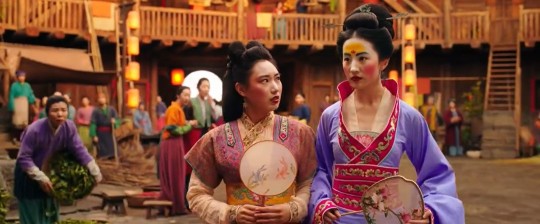
fig. 7 Scene in film featuring Mulan’s Hanfu from the matchmaking sequence
There’s nothing wrong with taking artistic liberties for costumes with a historical context. For instance, exaggerating certain characteristics of the era the story is in, or modernizing certain features so that they align with the character’s more modern way of thinking to contrast with the traditional setting. Good examples that come to mind are the costume designs in Marie Antoinette (2006), or Nirvana in Fire (2015), which also happens to be a Chinese period piece set in a fictional, historically ambiguous era. Inspiration for its costume design is taken from the Han Dynasty and the Southern and Northern Dynasties, so its costumes combine clothing silhouettes from the two periods, and use different characteristics such as colour to reflect class and status, and to represent characters’ personalities. It does a really good job of creating a new style while still giving subtle visual cues to the audience.
But Mulan’s dress can hardly be called an interpretation of traditional Chinese clothing. This is something the animated film did poorly on as well, and this probably contributed to the costume design in this film as an adaptation of the cartoon. The fabric had a shiny sheen that cheapened the costume. Coupled with the strange silhouette of the Hanfu (especially the bottom part of the skirt), this further detaches the audience from any hint of authenticity. The pictures below can speak for themselves. If they’re aiming for ambiguity in terms of the dynasties as seen in the set, then at least make something that is visually pleasing??
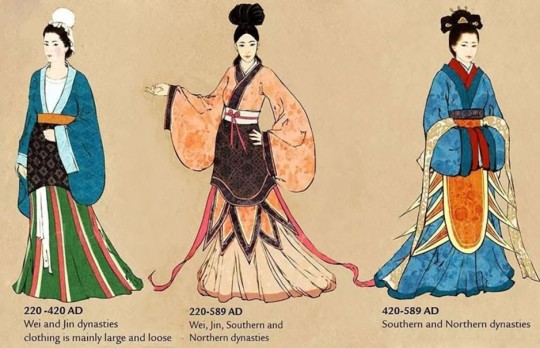
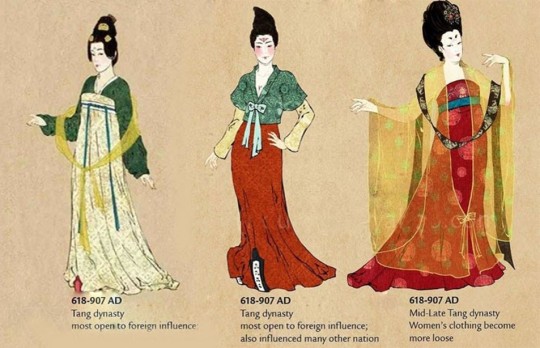
fig. 8 Evolution of Hanfu

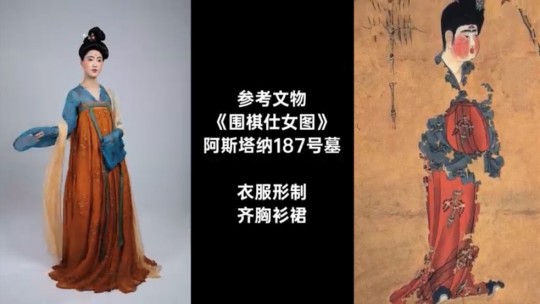
fig. 9 Tang Hanfu recreated with references from Tang artifacts (top: early Tang; bottom: golden era of the Tang period)
For whatever reason it seems like the extras in the background have more accurate costumes than the main character
And as a girl from a farming village why is she being trained like a noble lady??? A question I’ve had since the animated film…
The film wasn’t consistent when taking artistic liberties. Audiences subconsciously make visual connections to historical periods when watching a historical fiction film. It would be visually more cohesive if artistic liberties were taken on elements from one dynasty or by combining elements from dynasties with similar aesthetics, instead of jumping across centuries of very different stylistic approaches.
Basing the set design on the Tang Dynasty, but then including random shots of Qing Dynasty architecture of no particular importance (two very contrasting architectural styles); extras having Tang-style Hanfu, but Mulan not having one that's remotely close to any style of the multiple dynasties the film has taken inspiration from; alluding to the time period in which the ballad was written by painting Mulan’s forehead yellow 黃額妝 (which was poorly done but I digress), a style of makeup used by women of the Six dynasties and the Southern and Northern Dynasties (六朝女子), but everything else alludes to Tang or later. And finally, basing many things off the Tang Dynasty, but the Tang wasn’t in risk of invasion from the Huns or the Rouran??? We’re fucking confused :)
Small details like the ones we’ve listed above are visually off-putting; as an audience member I’m immediately thrown out of whatever universe the film is building due to the contradicting visual cues. If this was Disney’s and the director’s attempt at cultural accuracy, then it’s plainly insulting to the intelligence of their Chinese audience. (Respecting cultural concerns should not be Disney’s scapegoat for producing a bad movie.)
Ultimately, the film is based on a ballad and we wouldn’t say the points we’ve mentioned are considered common knowledge. So let’s treat it as a fictional era and put less significance on historical consistencies and authenticity. Let’s narrow it down to the crude representations (and misrepresentations) of general Chinese culture and society.
On Stereotypes
“Chi”: Why are soldiers receiving chi-related martial arts training, which takes years and years of elite, specialised training and experience? Ordinary soldiers don’t train their chi, they are not Wuxia 武俠 (roughly translates to martial arts chivalry). These people aren’t training for Jianghu martial art contests (江湖俠道的比武), they are training to kill for war, which does not require finesse at all. Even disregarding the lack of logic in training ordinary soldiers in martial arts (especially them teaching Taichi in the film), logistically it is simply not worth the economic and time cost of training entire regiments in martial arts only for them to be mostly killed off in battle. (Sorry, it’s difficult to explain wuxia and jianghu in a few words, but they’re super cool so please search them up if you’re interested!)
Many others on tumblr have commented on how chi itself is not the weird masculine "power" the film made it out to be, which is also very true (it's also actually very interesting so search it up if you want to!)
On Language as a Limitation
Clumsy translations of Chinese idioms and phrases that are just tragic comedy, e.g. 四兩撥千斤 being translated into “four ounces can move a thousand pounds”, which neglects the subtlety and gentle vibe of the original word choice while twisting the concept into something related to brute force or physics (but we guess this specific example is not entirely the screenwriters’ fault, since some English Taichi classes also translate it as that).
Replacing Chinese concepts and mythology directly with Western concepts such as witches, phoenixes rising from the ashes etc.
The single clumsy reference to the original “Ballad of Mulan” 雄兔腳撲朔,雌兔眼迷離;雙兔傍地走,安能辨我是雄雌?(translates to: when being held by the ears off the ground, male rabbits would have fidgeting front legs, while female rabbits close their eyes; who’s to tell male and female apart when the two rabbits are running side by side?) This line is an acknowledgement and compliment to Mulan’s intelligence and capabilities. It also challenges patriarchal beliefs of gender and women.
On Traditional Virtues (or the oversimplification of them, and a continuation of Language as a Limitation)
The film’s traditional values of 忠勇真 (translated as loyal, brave, and true in the film by using the most direct translations possible) and 孝 (translated as "devotion to family" in the film) seem to be a reference to the core values of Confucianism. We assume that the film is referencing these Confucian core values: 仁 (to be humane)、恕 (to forgive)、誠 (to be honest and sincere)、孝 (filial piety) and 尊王道 (to be loyal to the emperor). If the screenwriters were going to use traditional values, it is curious for them to choose only those three specifically, and to grossly simplify the actual values in their choice of Chinese characters (instead of using the conventional characters), then to grossly simplify them again in their English translations, and then to put them together in that order. The film also just briefly goes over the values by plainly listing them out in the form of an oath, thereby erasing the complexities of the values...
In a hilarious weibo post by 十四皮一下特别开心, they point out that the three values of 忠勇真 used in the film actually directly translate and correspond to the FBI motto of “Fidelity, Bravery, Integrity” :)
Let’s talk about 孝, the fourth traditional virtue engraved in the sword gifted to Mulan by the emperor at the end of the film. Over everything else, this is the original ballad’s central moral, and what we believe the film is also trying to evoke, so the weak translation diminishes the story’s message. The animation was smart in not directly translating it and instead demonstrates what it entails through the progression of the plot. The film does the opposite and translates it as “devotion to family”, when they could have just referred to it as filial piety. Care, respect, thankfulness and giving back to one’s parents and elderly family members. While obedience and devotion are part of what the virtue teaches, it's not supposed to sound like an obligation, it’s not something ritualistic, it’s just something everyone does as a “good” human being.
(And if the director and screenwriters were trying to diminish the role and significance of filial piety in the film on purpose because they wanted Mulan to appear “stronger” and “individualistic”, then… I really have no words for how painfully insensitive that is in terms of how white feminism does not and should not apply to or be imposed on other cultures.)
And here’s our list of Things That Also Pissed Us Off that other people on tumblr have talked about already, which is why we’re mentioning them without much elaboration:
On Feminism
We get that Disney was trying to make a female empowerment movie but they really missed the mark? Even with a female director, somehow. Stepping back and ignoring the Chinese aspects of the film, as a female audience this film was equally, if not more, hurtful
Mulan is only seen as “strong” because of her extraordinarily powerful “gift” of chi that led to her being physically more powerful than the men, especially in that scene where she lugs the two buckets of water to the peak of the mountain (which is in sharp contrast to how Mulan in the animated film is strong because she’s intelligent and is able to utilise teamwork and her strengths properly, and doesn’t let her understandable disadvantage in terms of physical strength trip her up)
All female characters are one-dimensional as fuck and are mere caricatures (though to be fair, the male characters aren’t treated much better) BUT PEOPLE, MULAN IS THE MAIN CHARACTER!! Her name is literally the name of the film!!! Maybe give her some character??? And what happened to wanting to produce good Asian representation in Hollywood???
The character of the witch was slightly more complex than everyone else, which, good for her, but then the screenwriters had her killed when she could easily have not been written with that conclusion to her arc?? Seems to us like some bullshit where the witch had to be punished in a narrative sense because she “succumbed” to using her powers (which are again dubiously chi-related) for “evil”, when instead she was merely trying to achieve as much as she could for herself in a patriarchal system designed to punish her
Plus the implication of writing the sequence of the witch sacrificing herself for Mulan is that Mulan is inherently more worthy of protection because she’s more “noble”, which, again, we call bullshit. Mulan achieved (impossible) success and validation in a patriarchal system because she played by their rules of what it means to be a masculine “warrior” and excelled, while the witch is scorned and punished within the story and also in a narrative sense because she doesn’t. Is that really what it means to be noble and good???? Does that really make Mulan superior to the witch?? (Honestly this plot point might have worked if there was more complexity written into the script, but unfortunately there wasn't)
Can’t believe they just threw away what could have been a perfectly complex and compelling relationship between Mulan and the witch because of shitty writing
The way Mulan lets her hair down and dumps her armour as an indication of her female identity (which is irritating to us on so many levels, as explained by various tumblr users)
On Production
Plot and character arcs have no emotional tension; they’re super rushed and super shallow; emotional beats are not hit properly (e.g. Mulan’s loyalty and friendship towards the soldiers, built up with one line from Honghui “you can turn your back on me...but please don’t turn your back on them” kind of bullshit)
The screenwriters would not know character depth or development even if it were shoved in their face
Blatant symbolism and metaphors (e.g. the fucking phoenix, and thank fuck it doesn’t look like a western phoenix) that make the film feel very… low.
Cinematography and editing: some very beautiful and compositionally interesting shots, but the battle scenes lack tension. The jump cuts disrupt the rhythm and intensity of the fighting; in combination with the overuse of slow motion, they drag the pace of the choreography and further slow down the rhythm of the scene. Exaggerated colour toning make certain scenes more fantastical than others, resulting in a mix of realistic landscapes in some scenes and highly saturated unnatural colours in others, which draws the audience in and out of the film’s universe. This is a shame because they actually took the effort to film in real landscapes.

fig. 10 Scene in film
Special effects: lack of blood in battle scenes (which, fine, they want it to be family-friendly) and Mulan’s suddenly clean face after she returns to her female identity visually puts off the audience (and links back to the issues surrounding the visual representation of her femininity)
And here’s the extremely short list of Things That We Liked:
That first fight scene between the witch and mulan when the witch brushes mulan’s hair away from her face with her claw while restraining her because that was gay as fuck and I am but a weak bisexual!!!
Donnie Yen’s action sequences lmao (they’re not even among the better ones he’s done so everyone go watch Ip Man for actually good action sequences and choreography)
Just listening to the soundtrack itself was great, loved the Reflection variations but I was simply too distracted by the other shitty things in the film
All-asian cast (thank fuck) with impressive actors and actresses (who should not be blamed for a shitty script)
TL;DR: This film is not worth your time or money. Inferior to the animated film (which already has a few questionable aspects). If you’re somehow really interested in seeing how badly Disney butchered Chinese culture (and to a certain extent the animated film), then just pirate this film. If you want to know what happened but can’t be bothered to waste your time watching the film, read this amazing and hilarious twitter thread by @XiranJayZhao, which we found right before we posted this review, and pretty much sums up our viewing experience as well.
Disclaimer: At the end of the day we're two girls from a predominantly Chinese society who are used to Chinese period films and dramas, watching Mulan (2020), a film primarily meant for Chinese diaspora and audiences in the West, with the Chinese market in Asia being just a secondary economic opportunity for Disney. We do realise that we aren't this film's target audience, and that we're not at all experts in everything we've discussed in this review. A lot of this is just us nitpicking, and all of it is just our personal (and very emotive) opinions from watching this film. Mostly we're just disappointed that the film was advertised to be relatively realistic and culturally accurate, but… wasn't.
Sigh.
Btw please feel free to ask us for recs of actually good, actually Chinese films and shows lmao.
Finally, all the love to our beta @keekry, for her many suggestions and hilarious comments!!!
#mulan#mulan 2020#mulan 1998#mulan live action#chinese culture#chinese architecture#chinese clothes#chinese costumes#chinese fashion#hanfu#mulan spoilers#long post#film review#disney#as a side note i have no idea why everyone thinks it's pronounced xian lang when in fact it's xian niang
15 notes
·
View notes